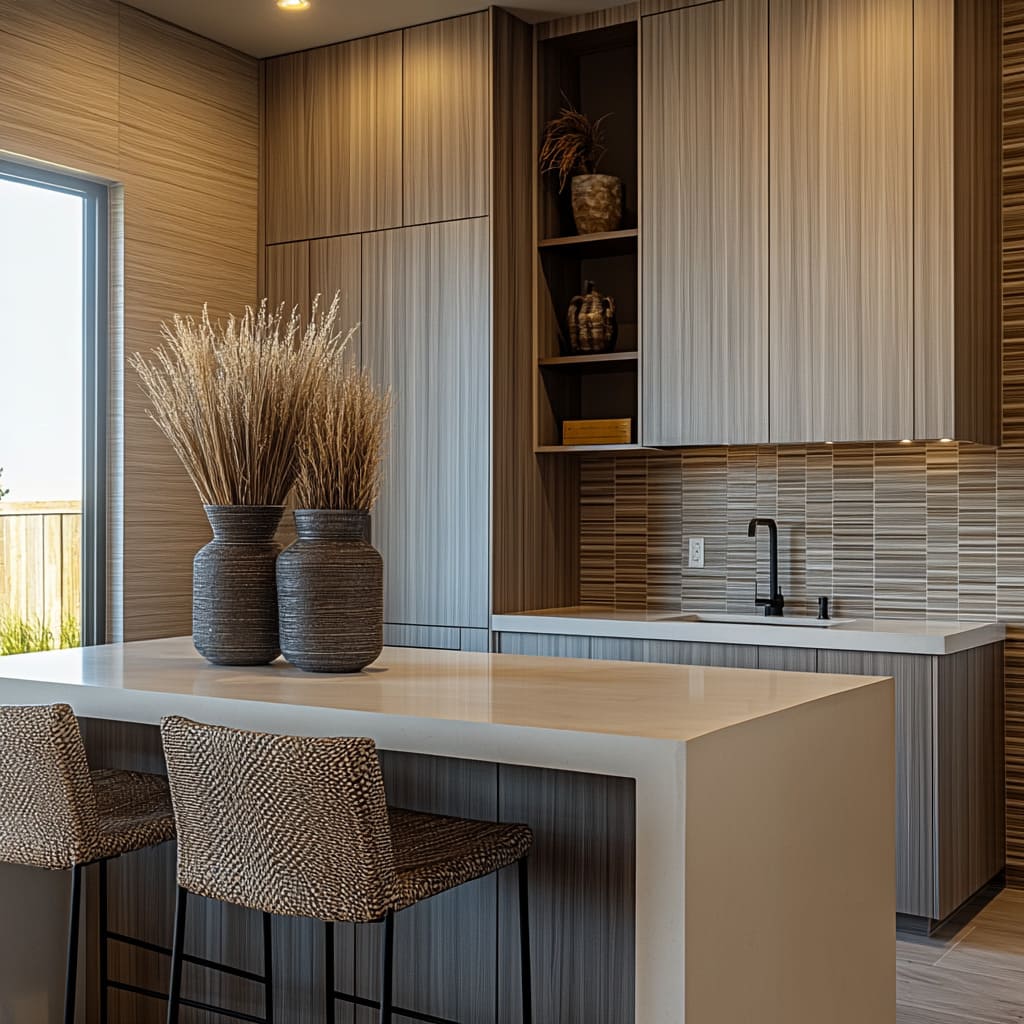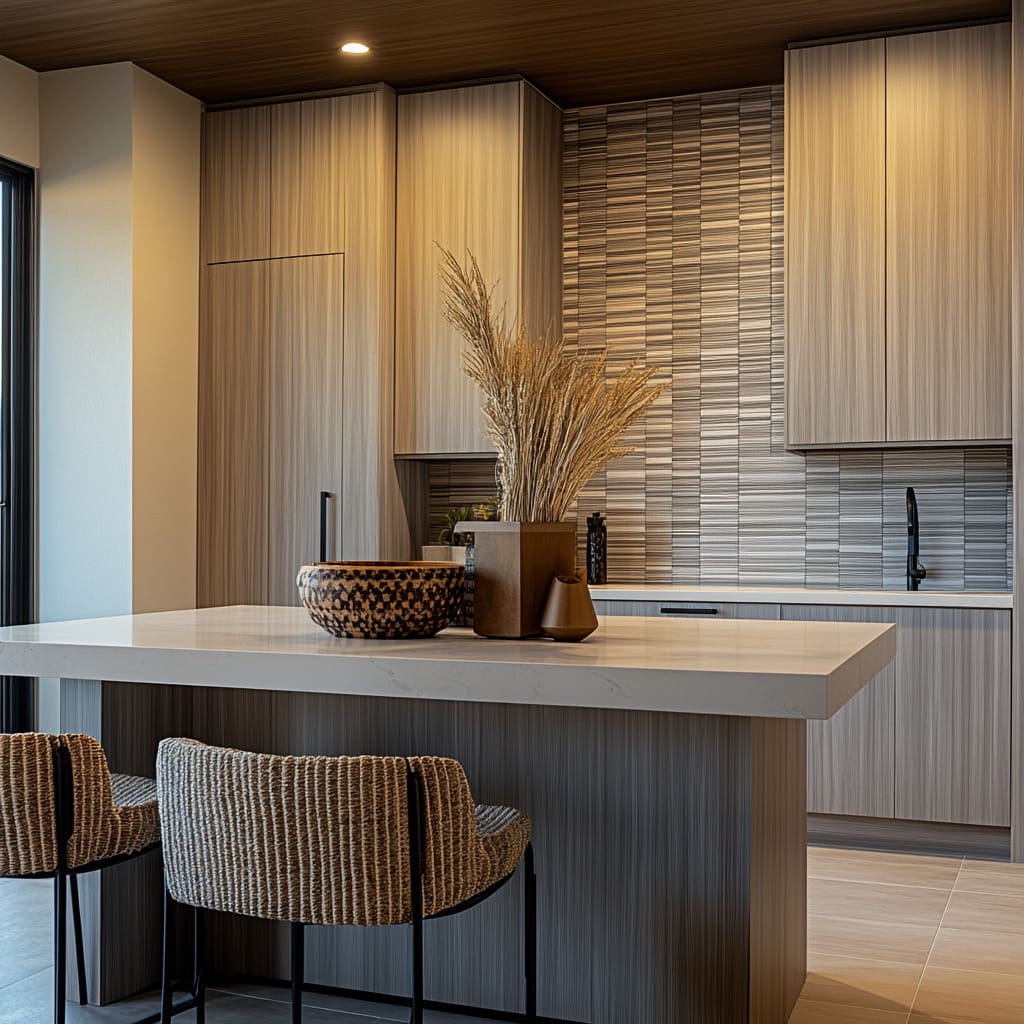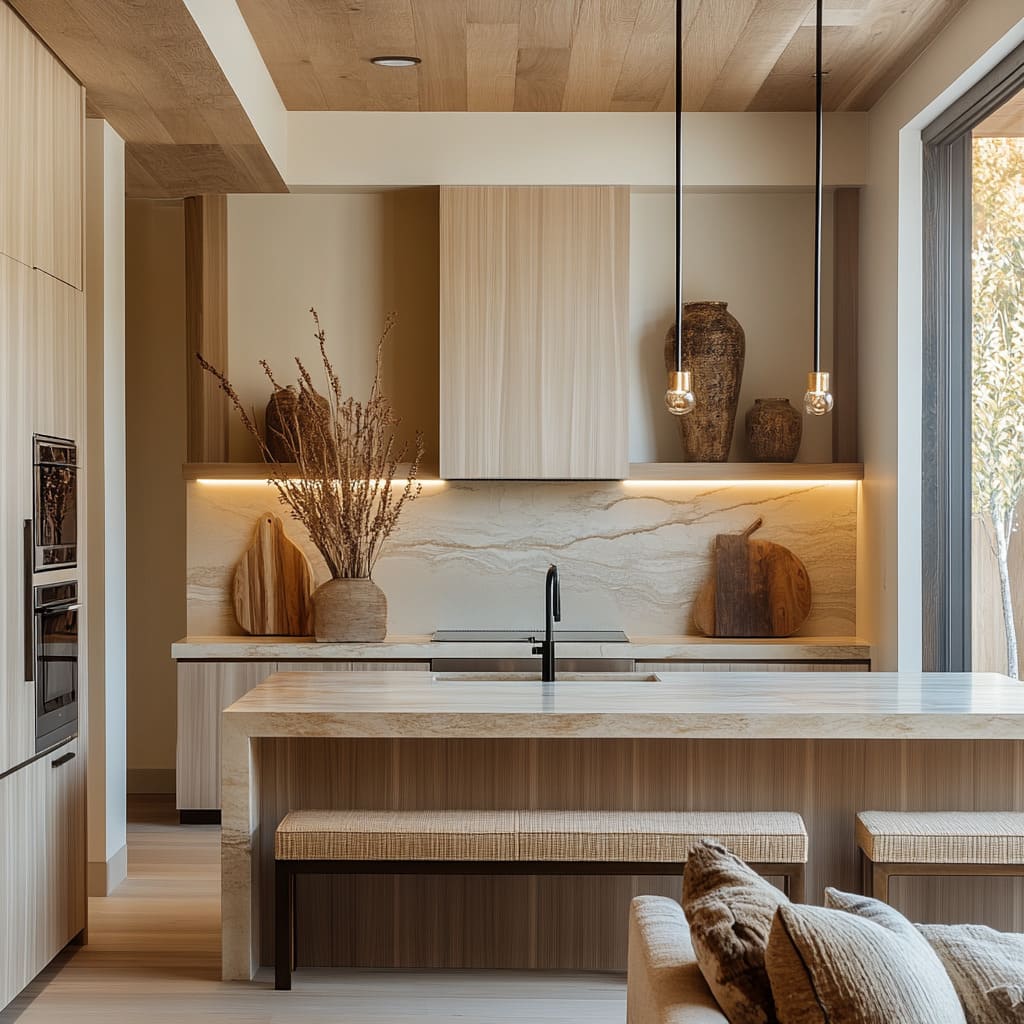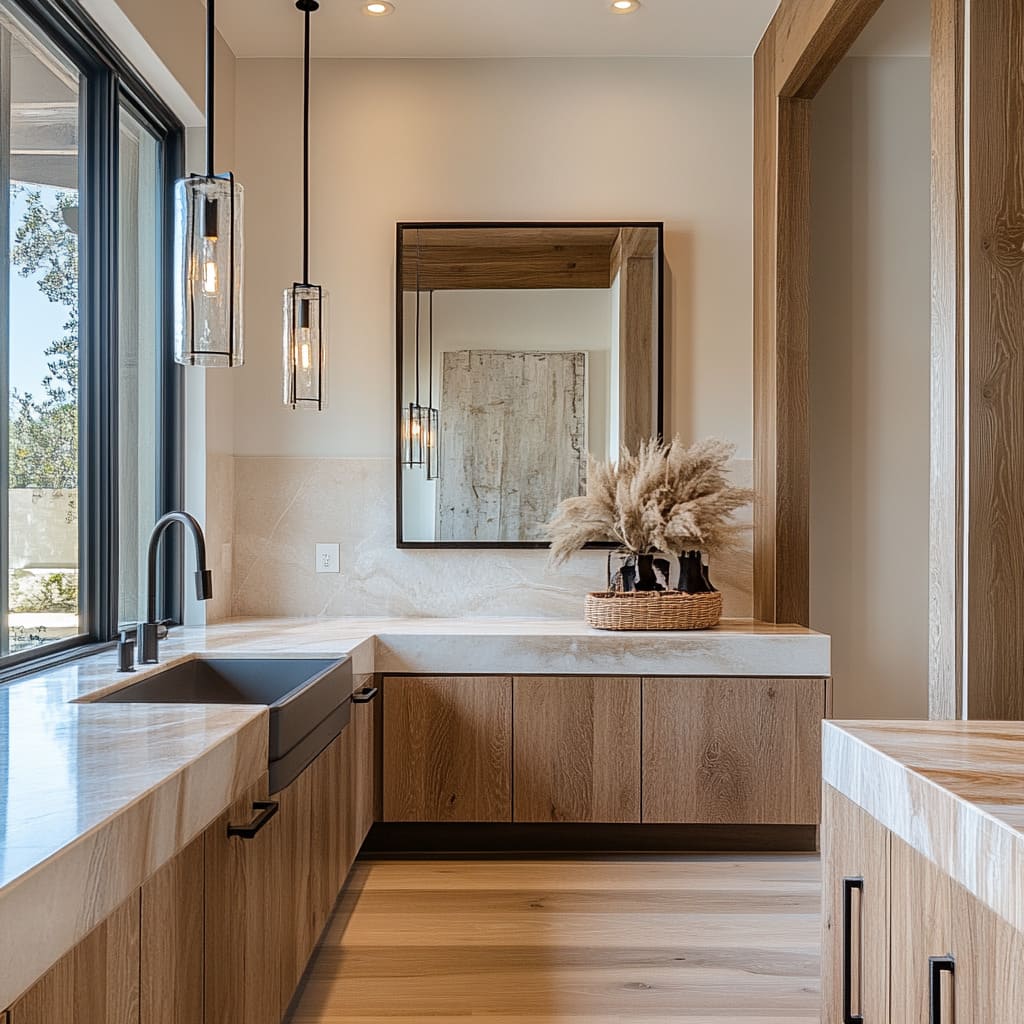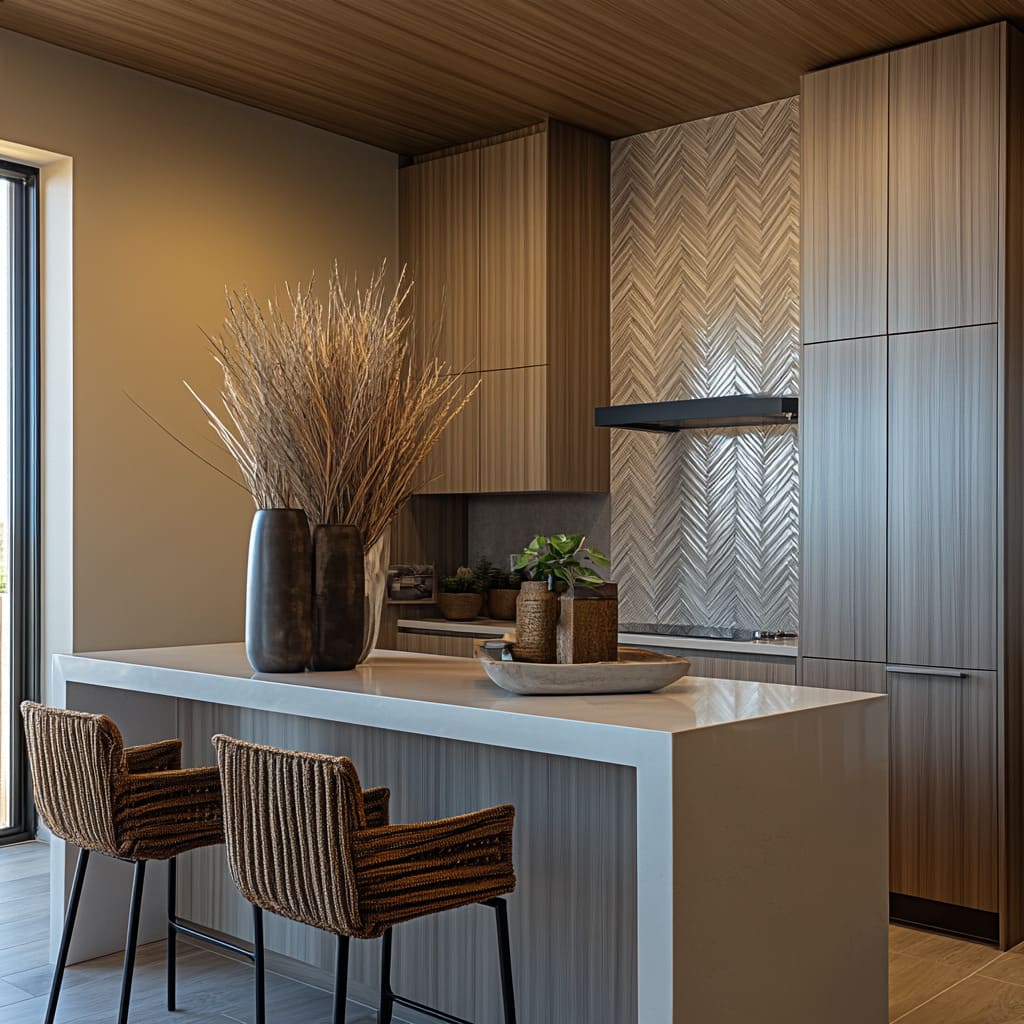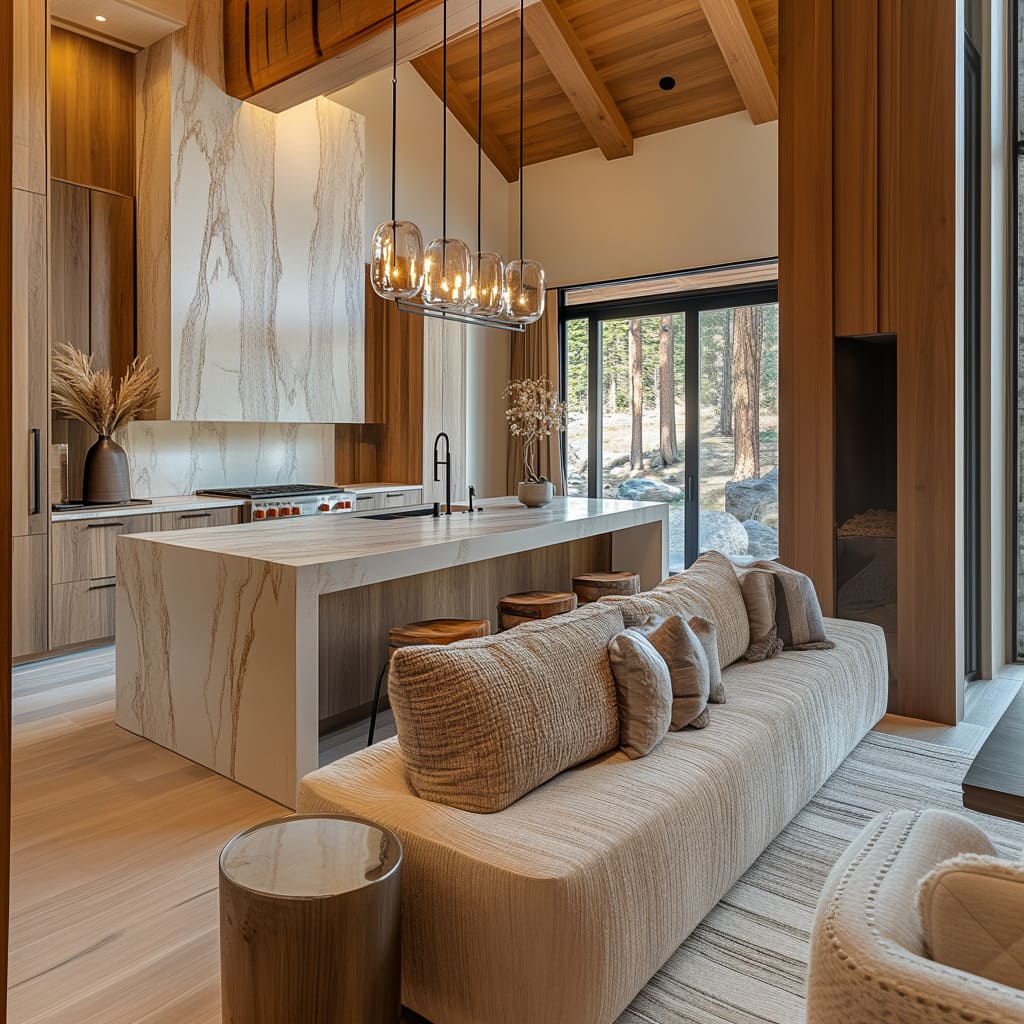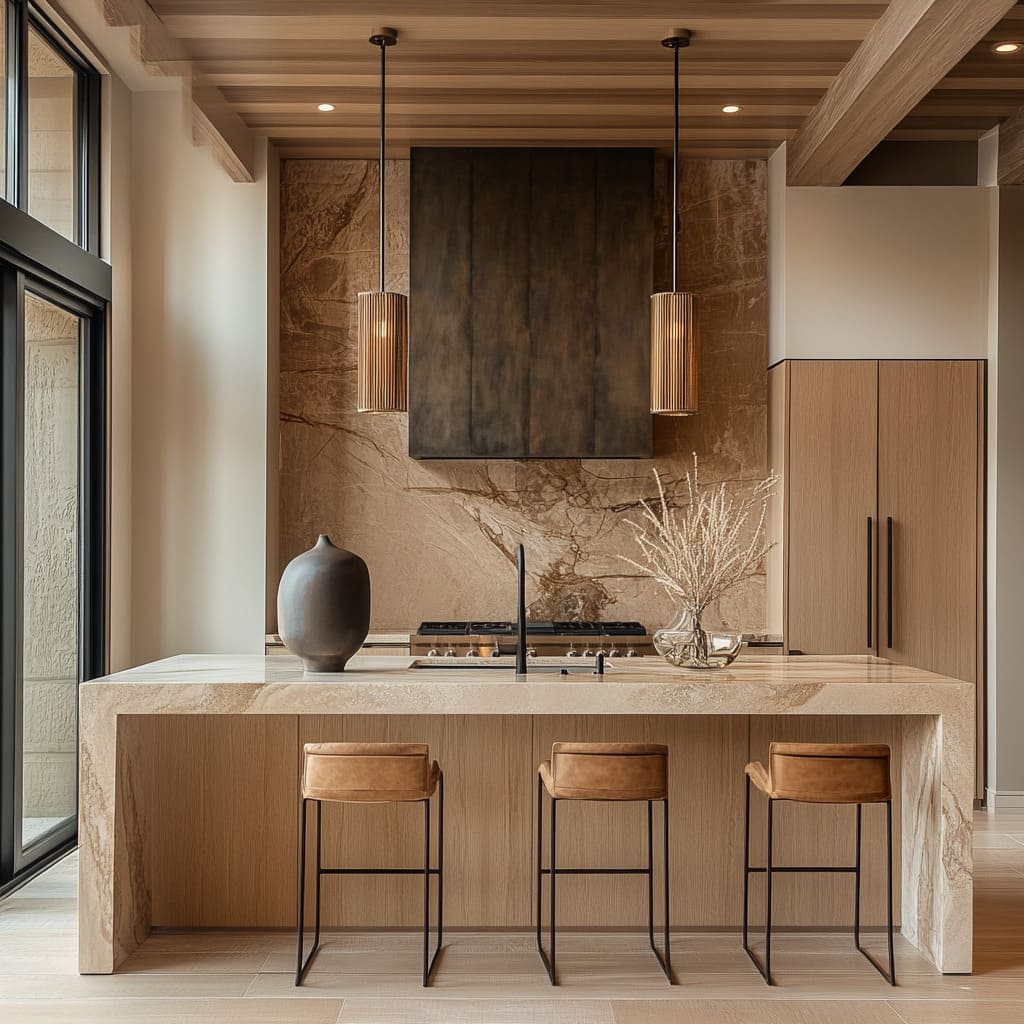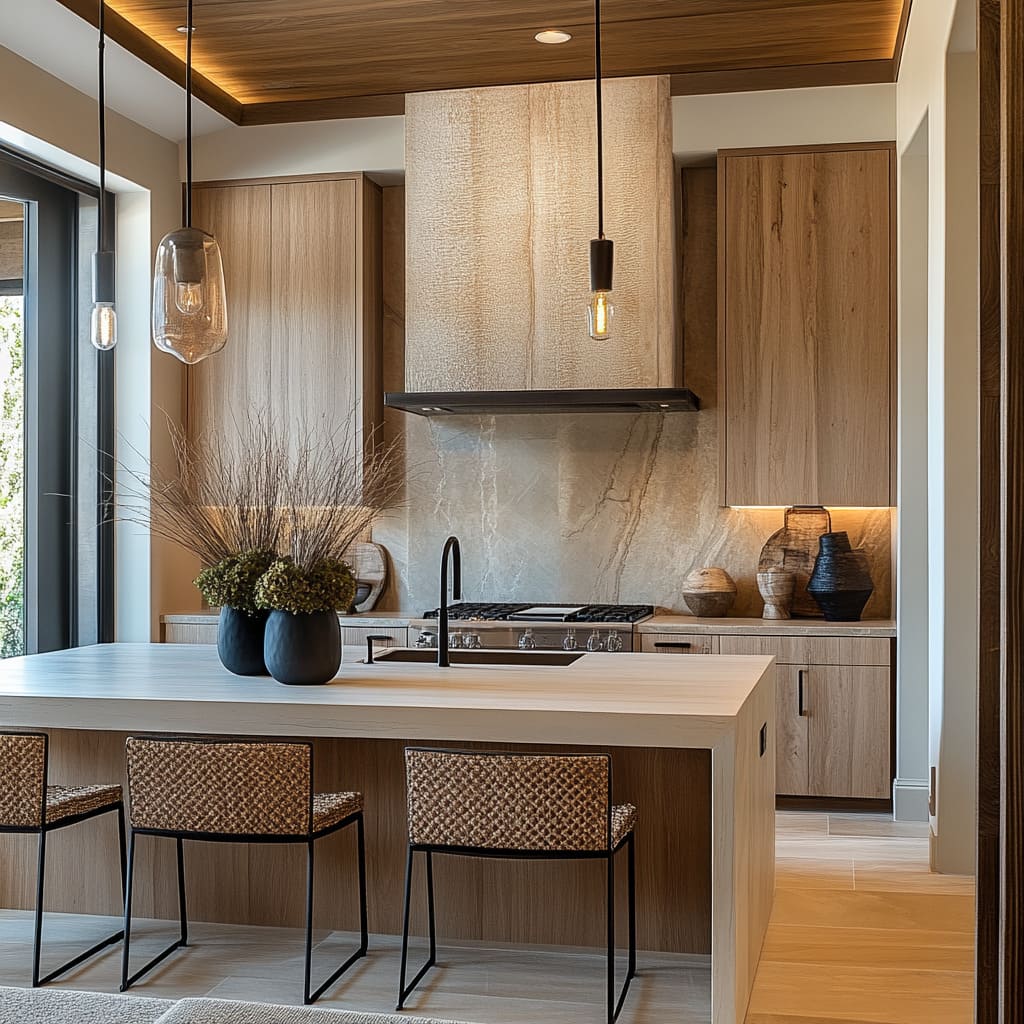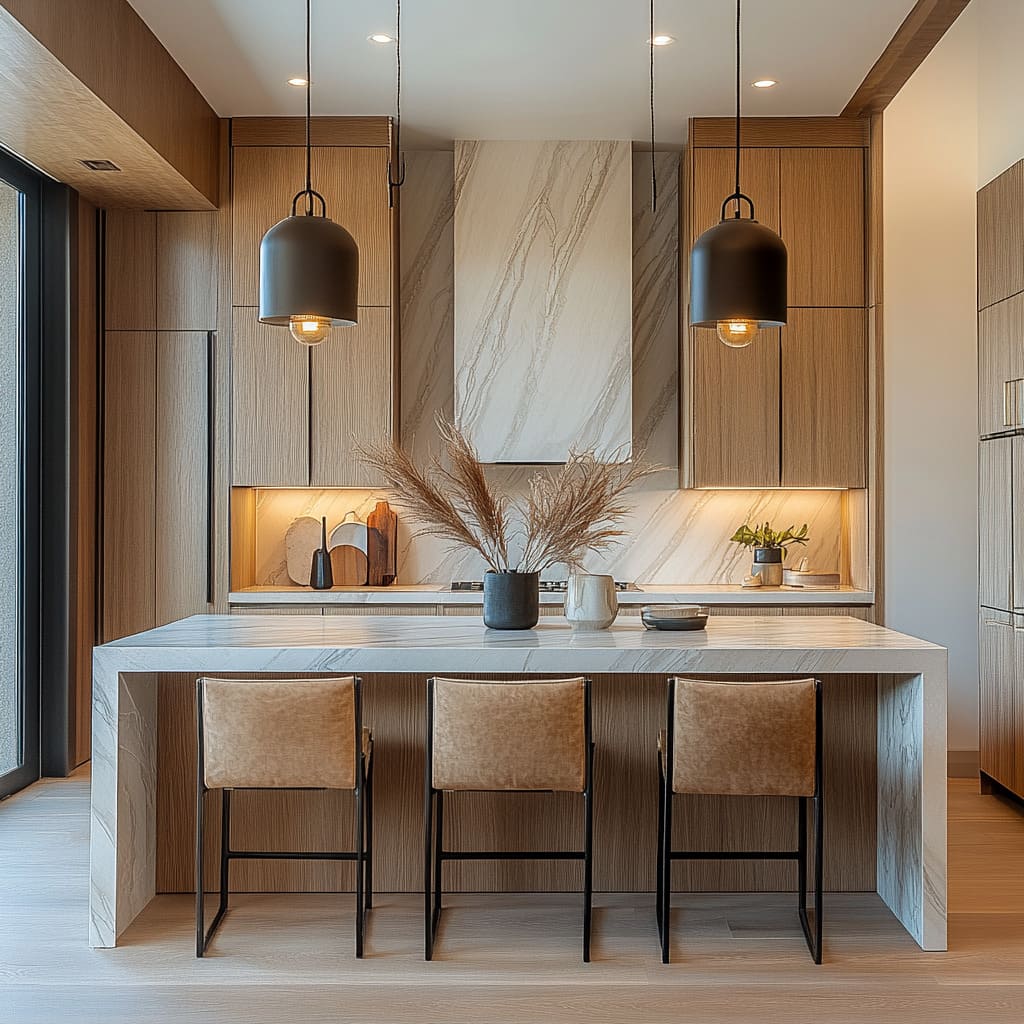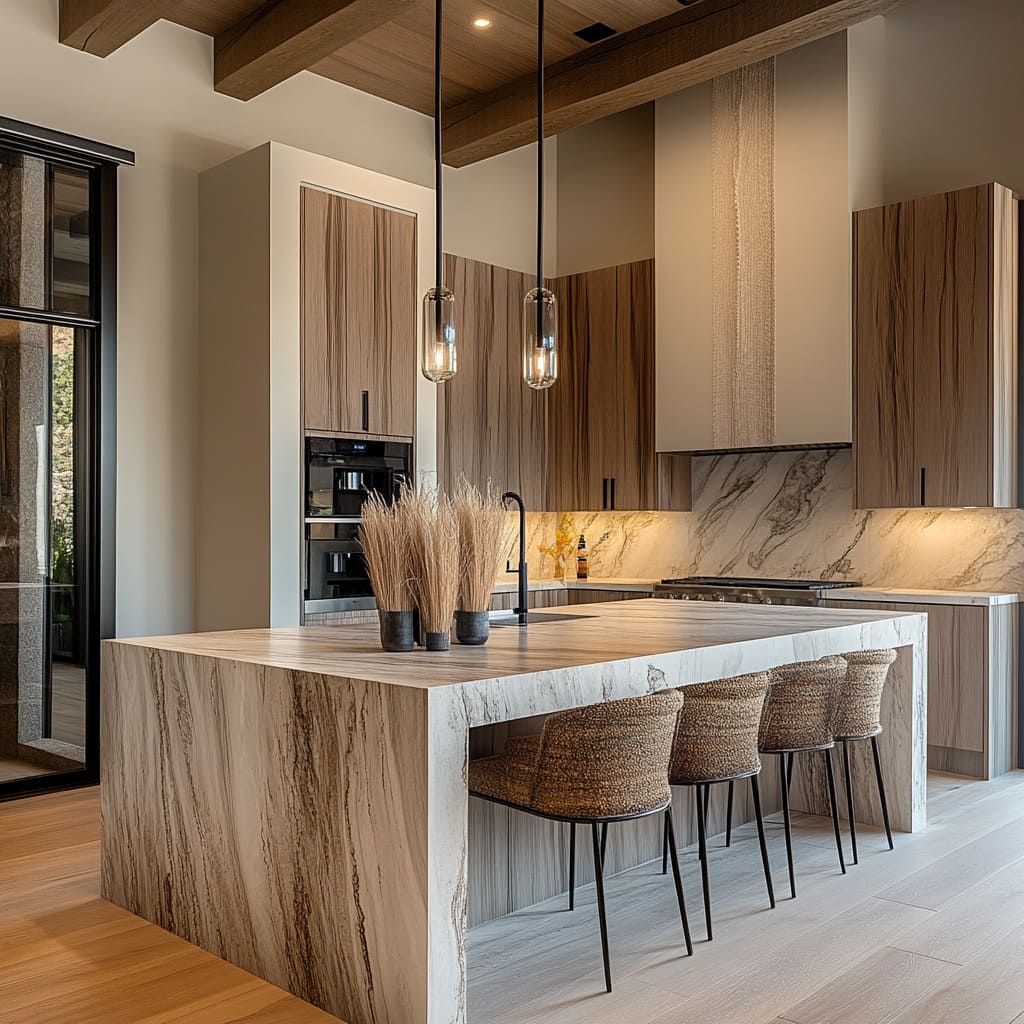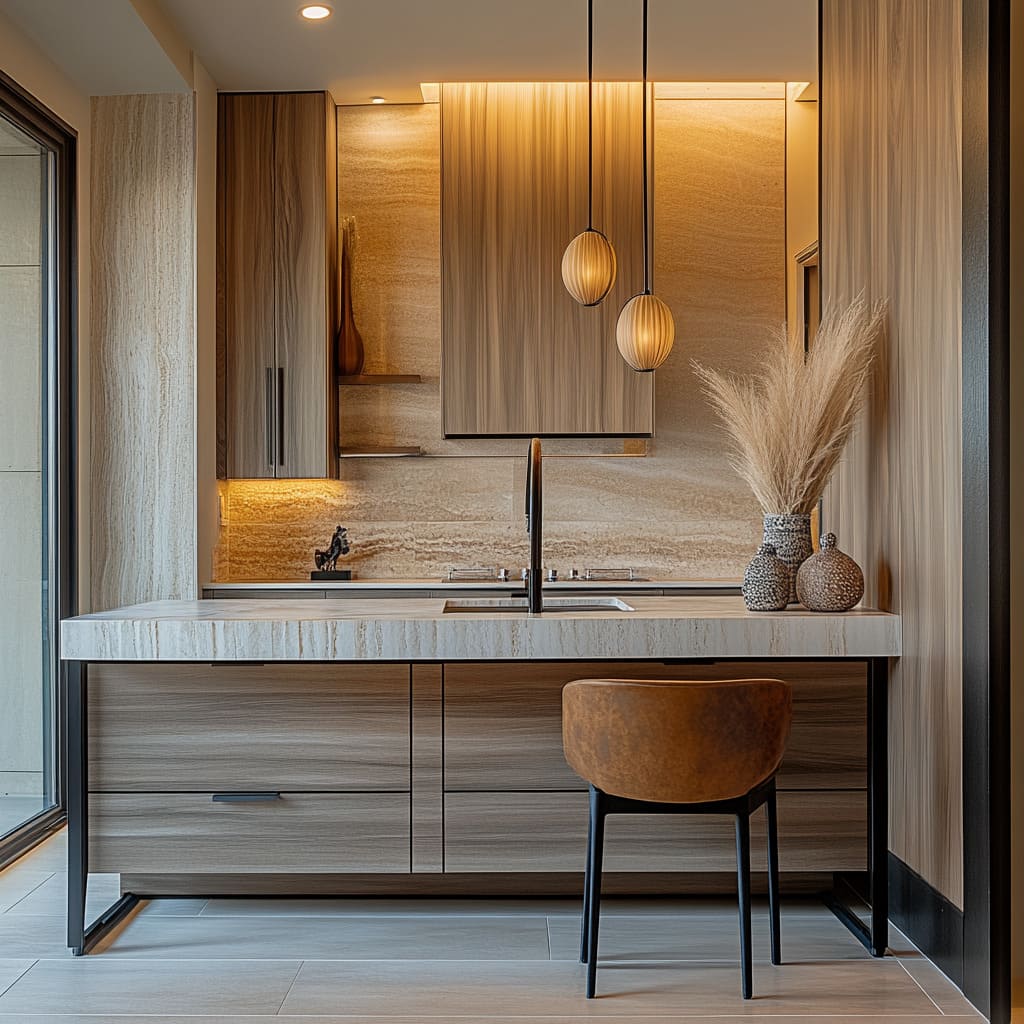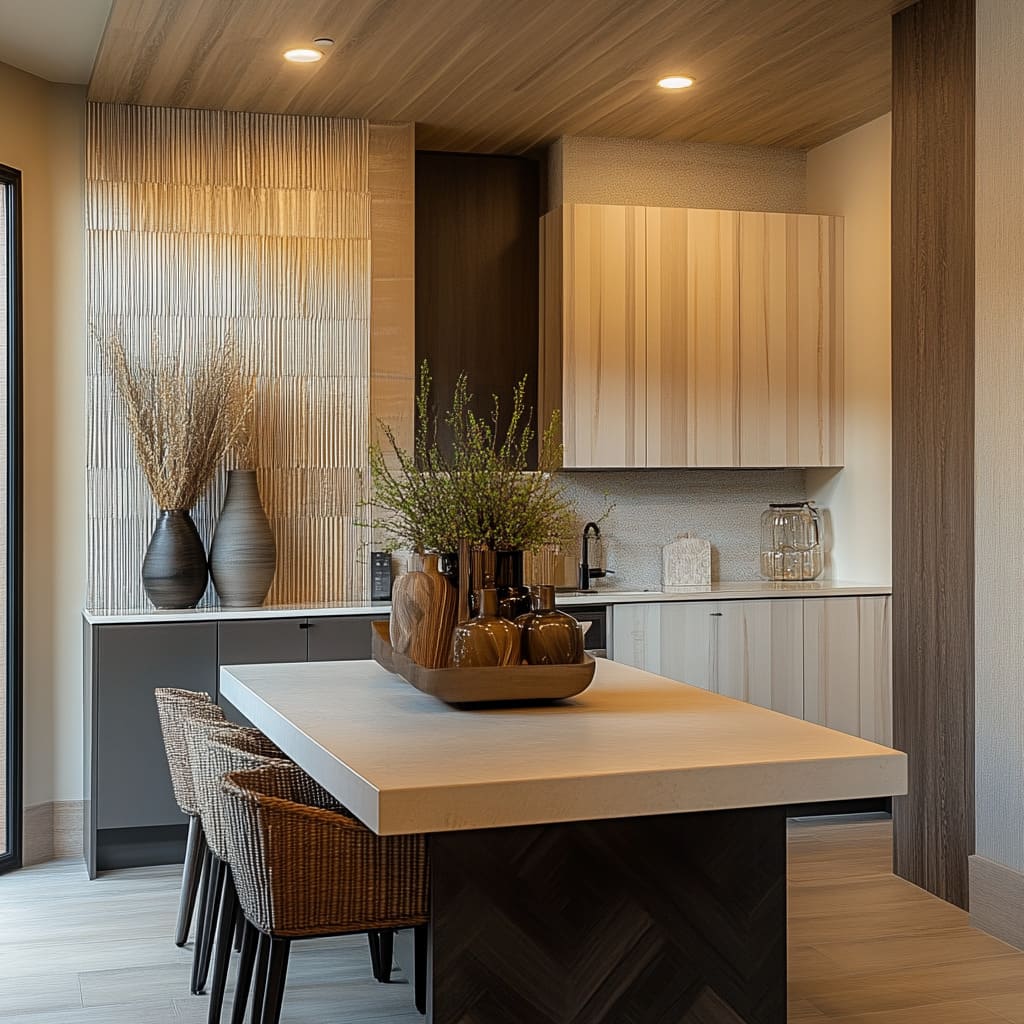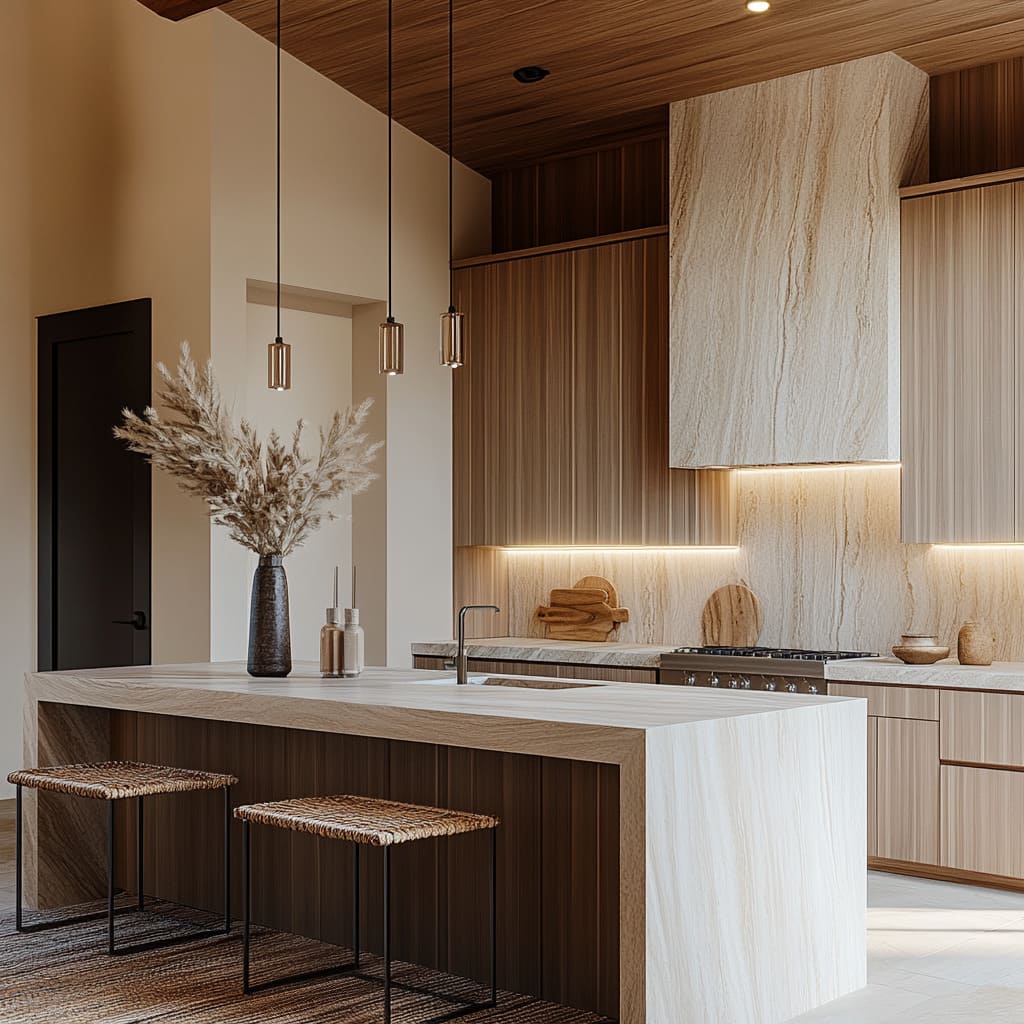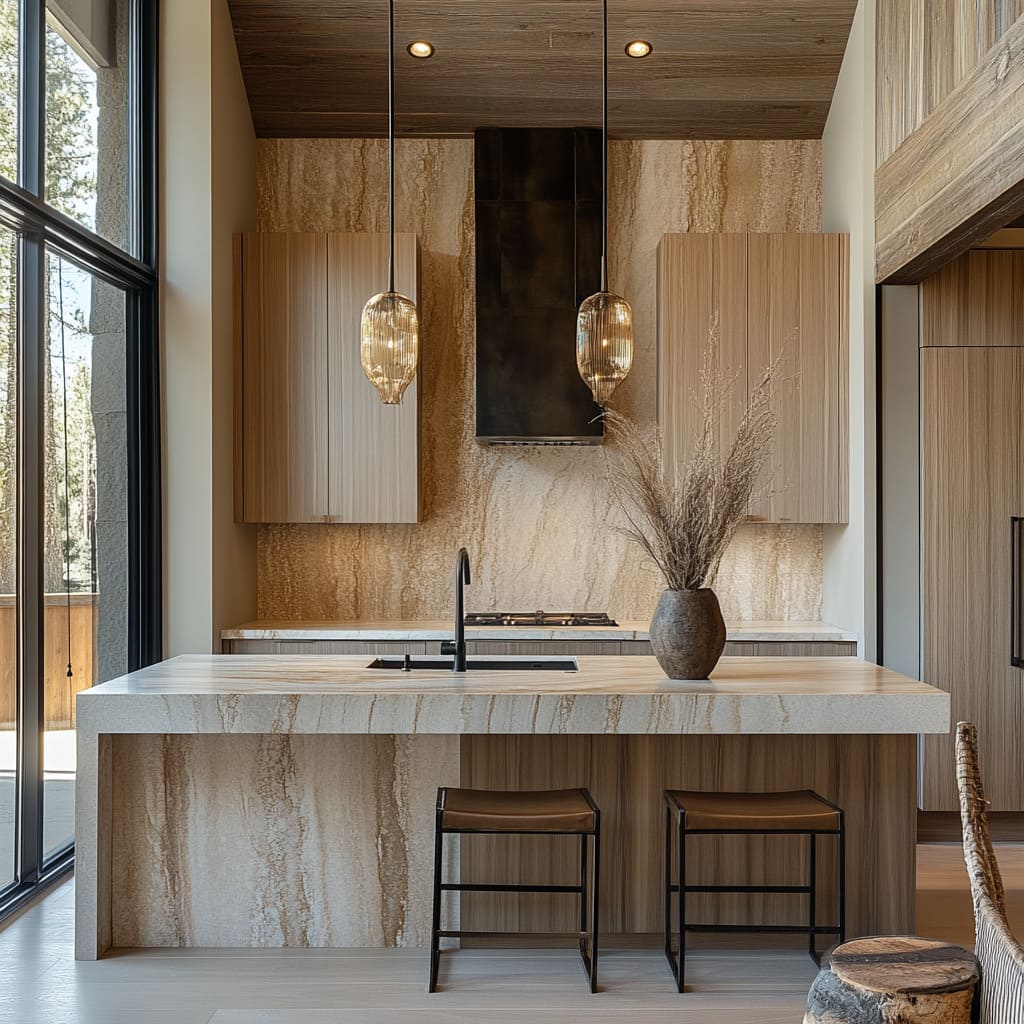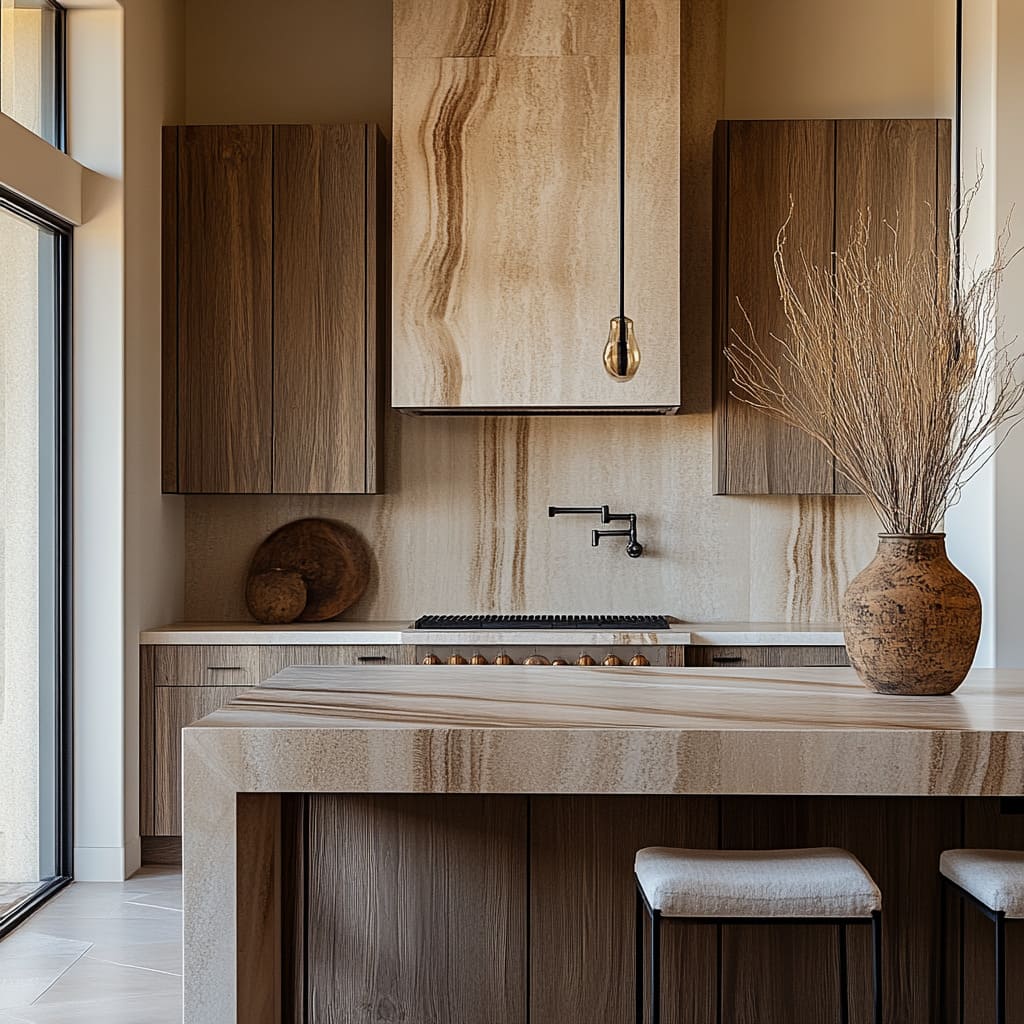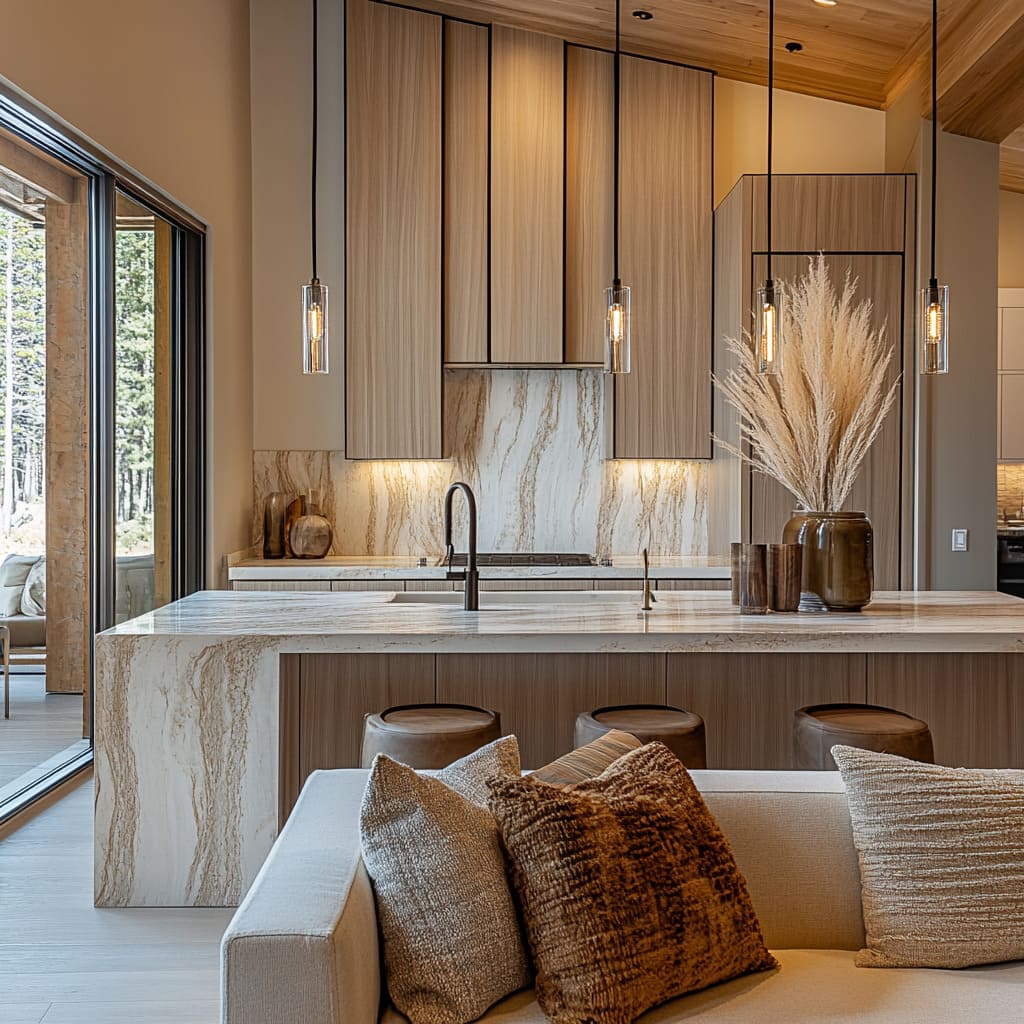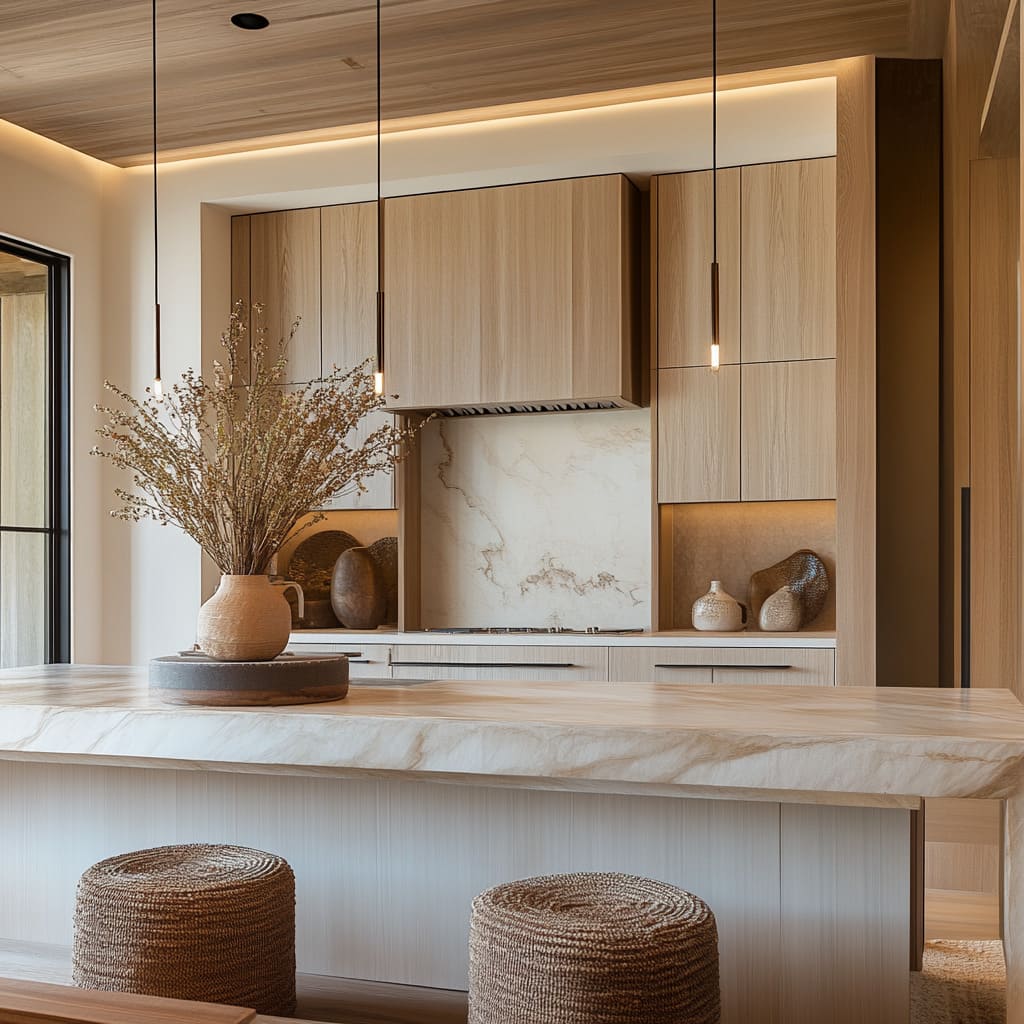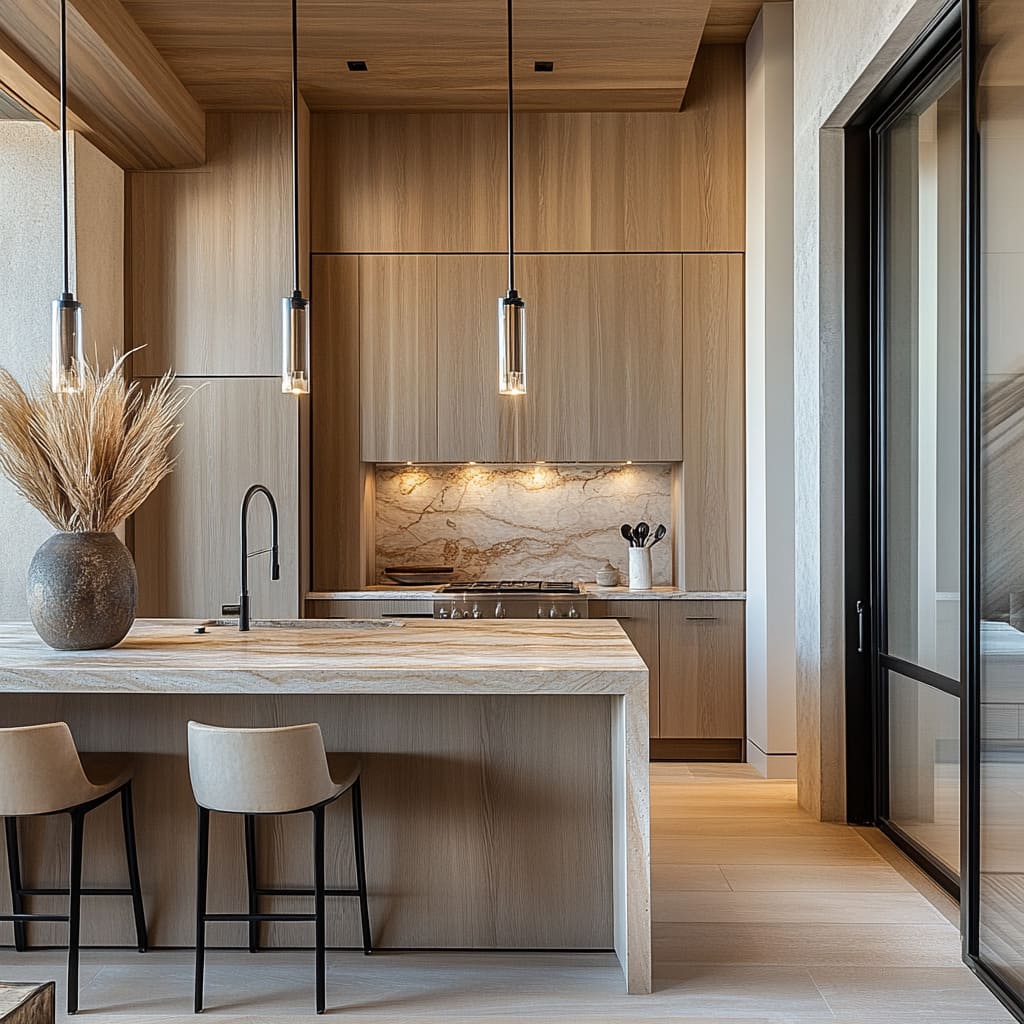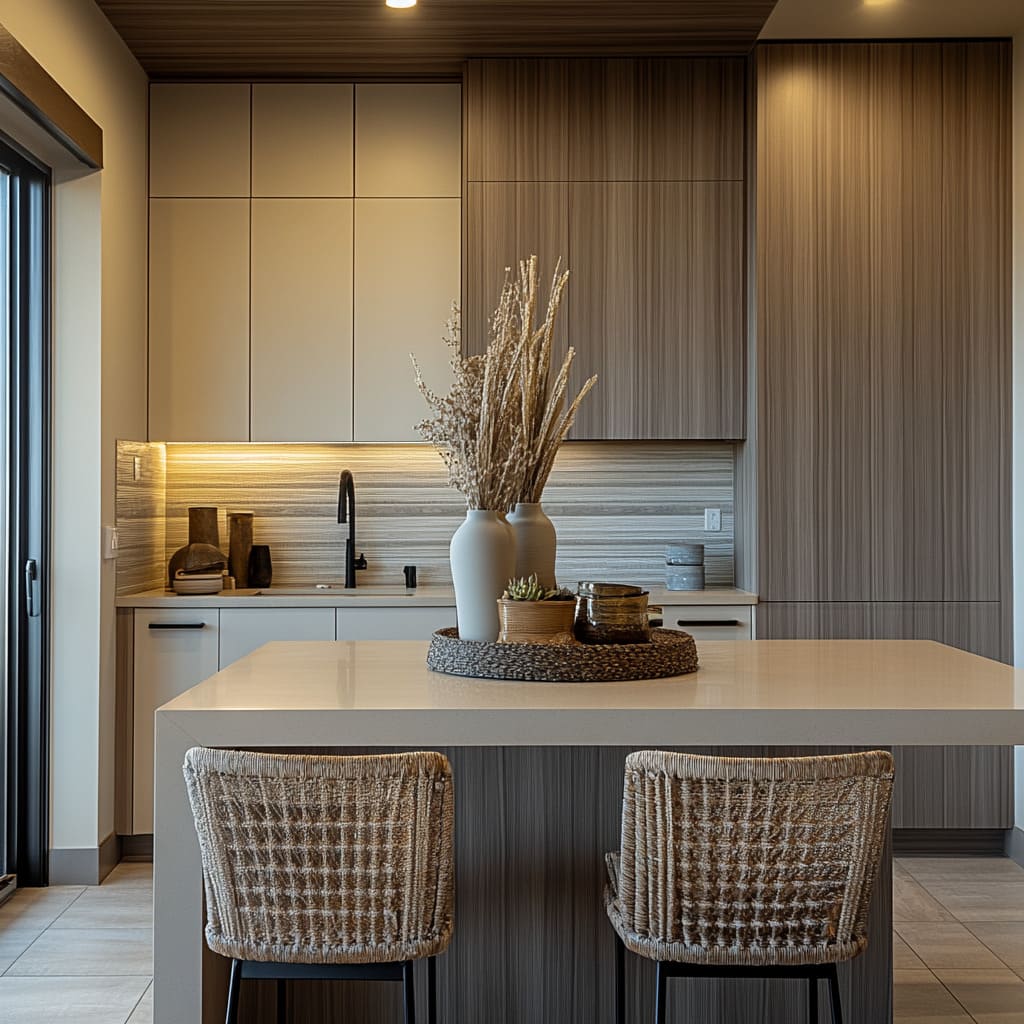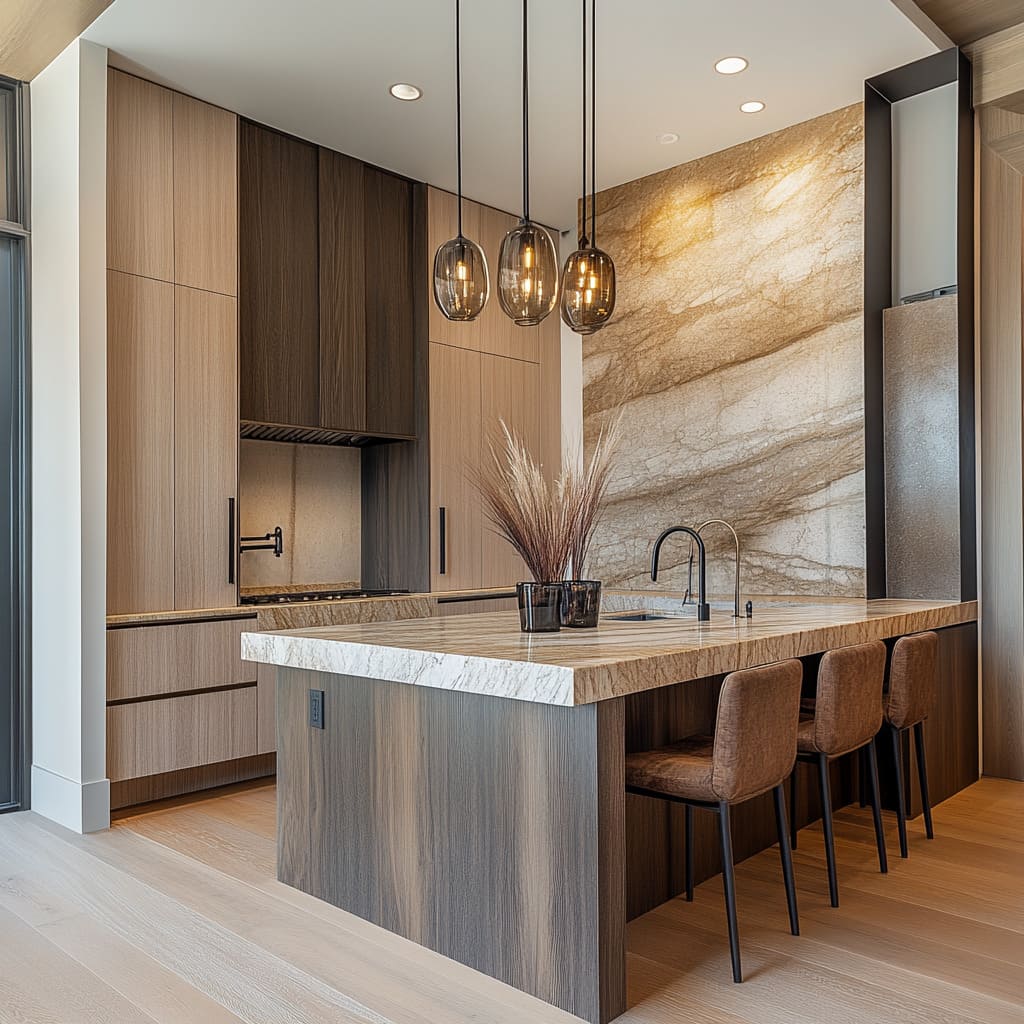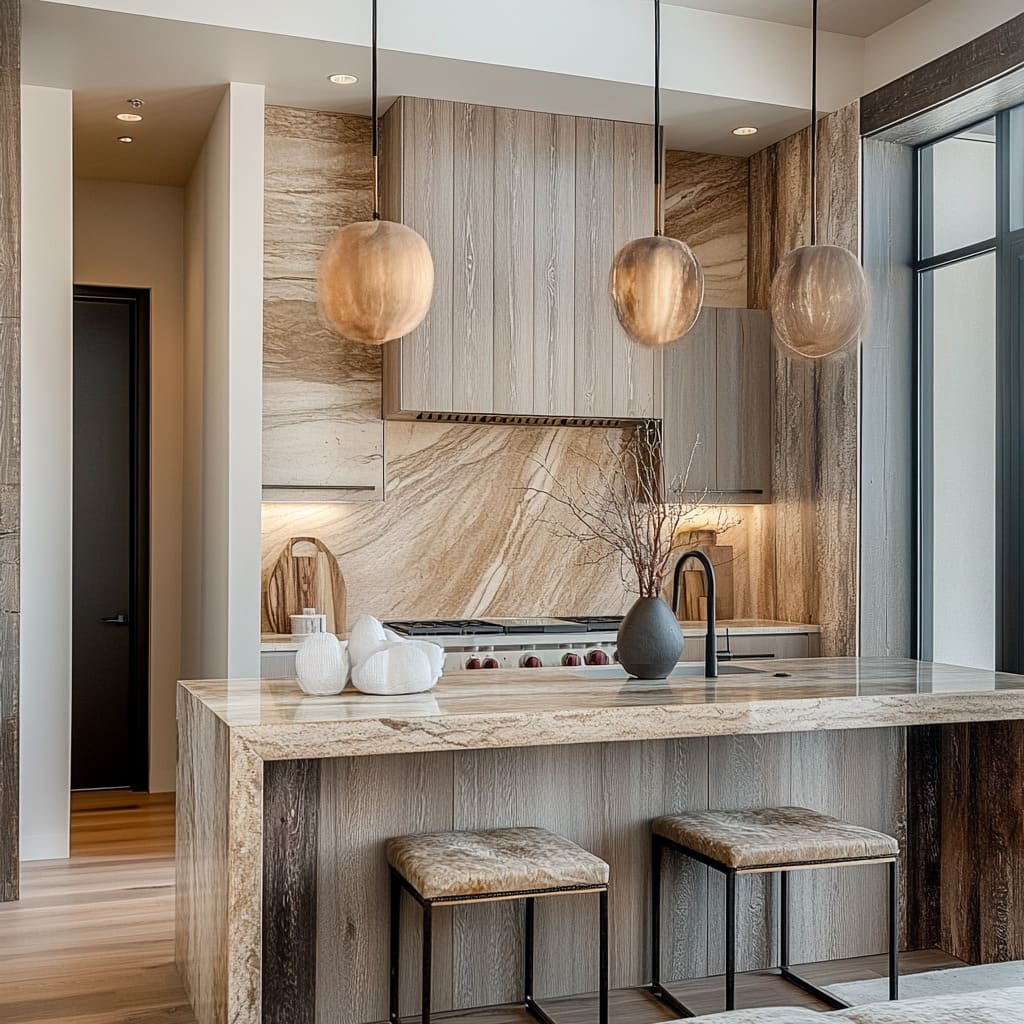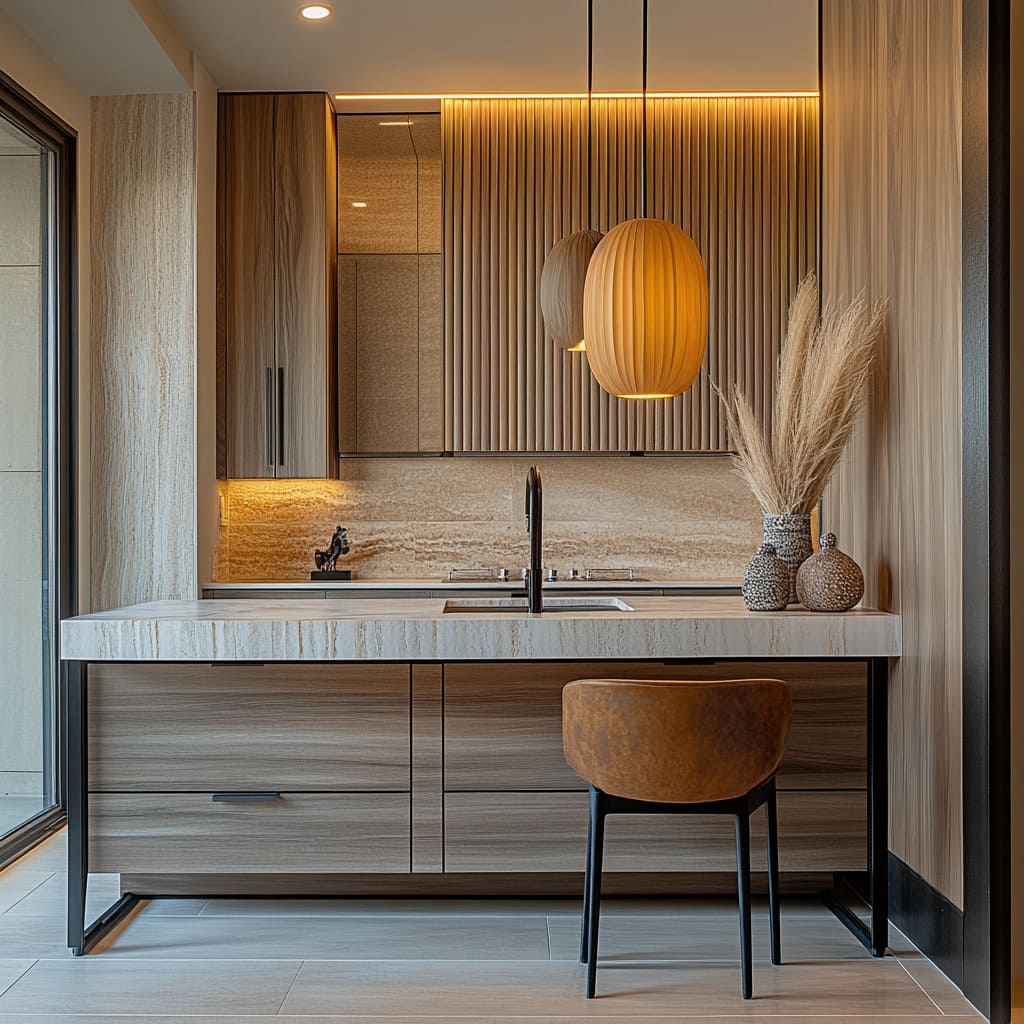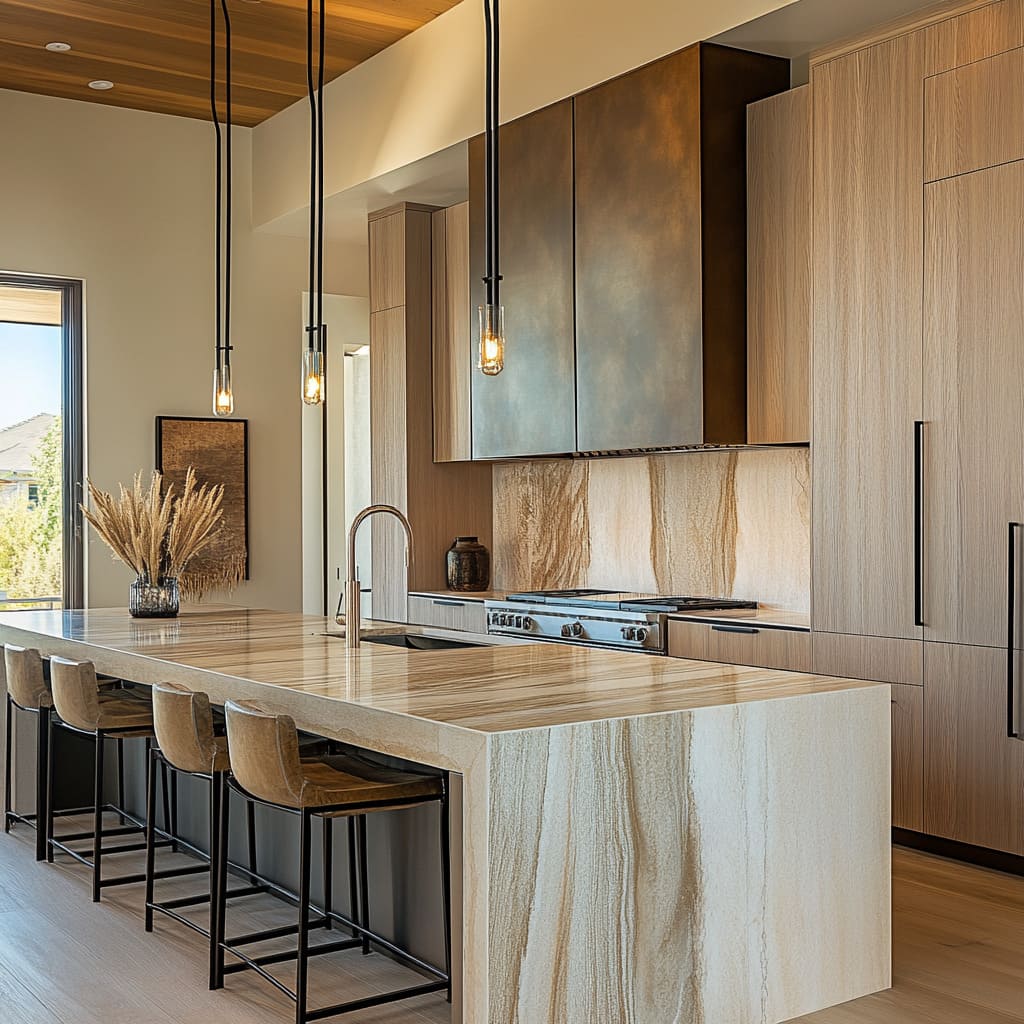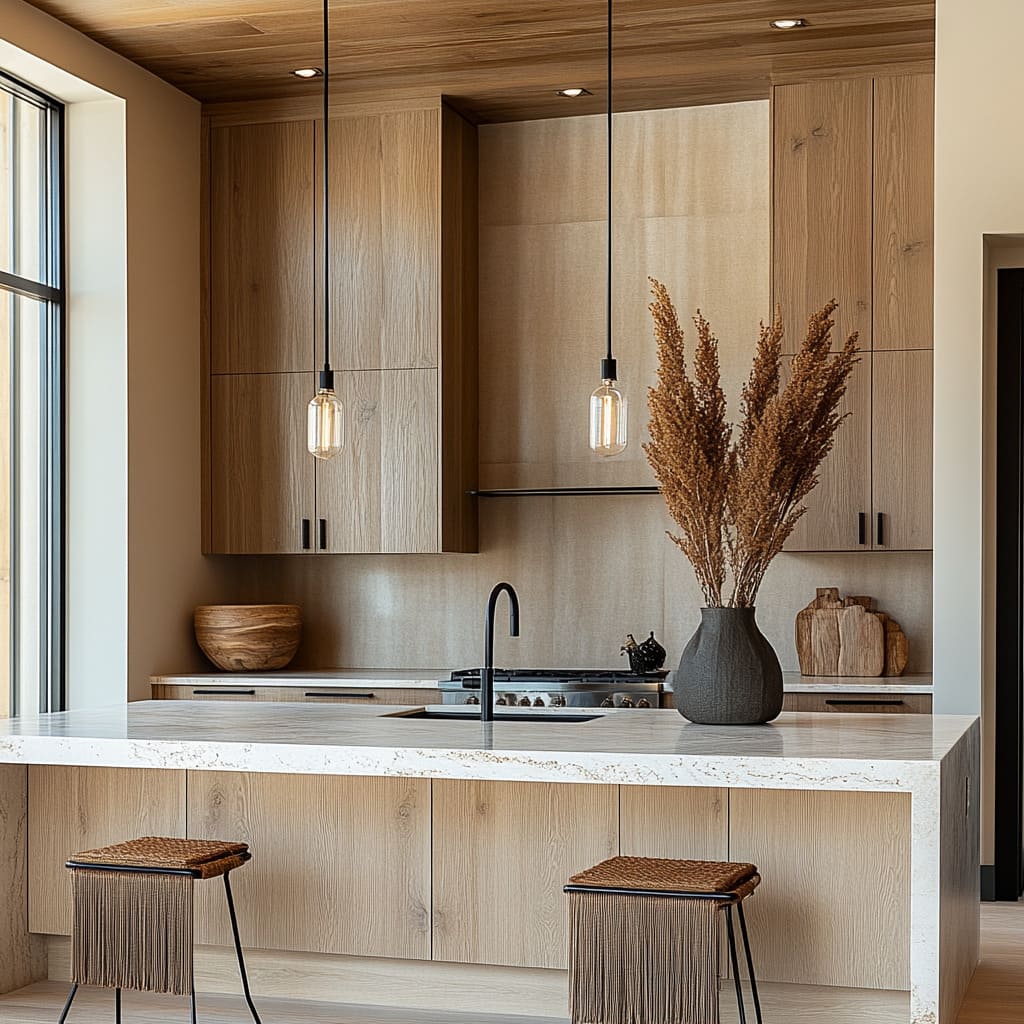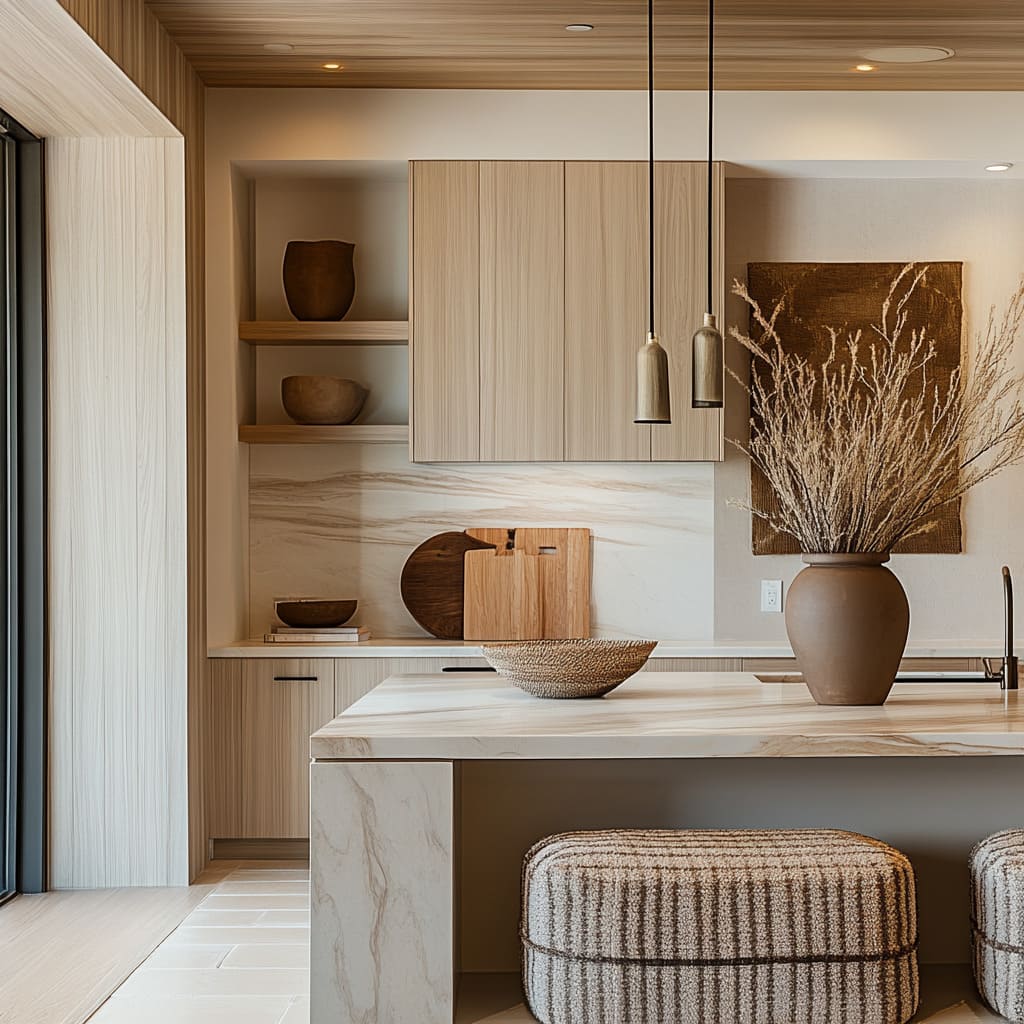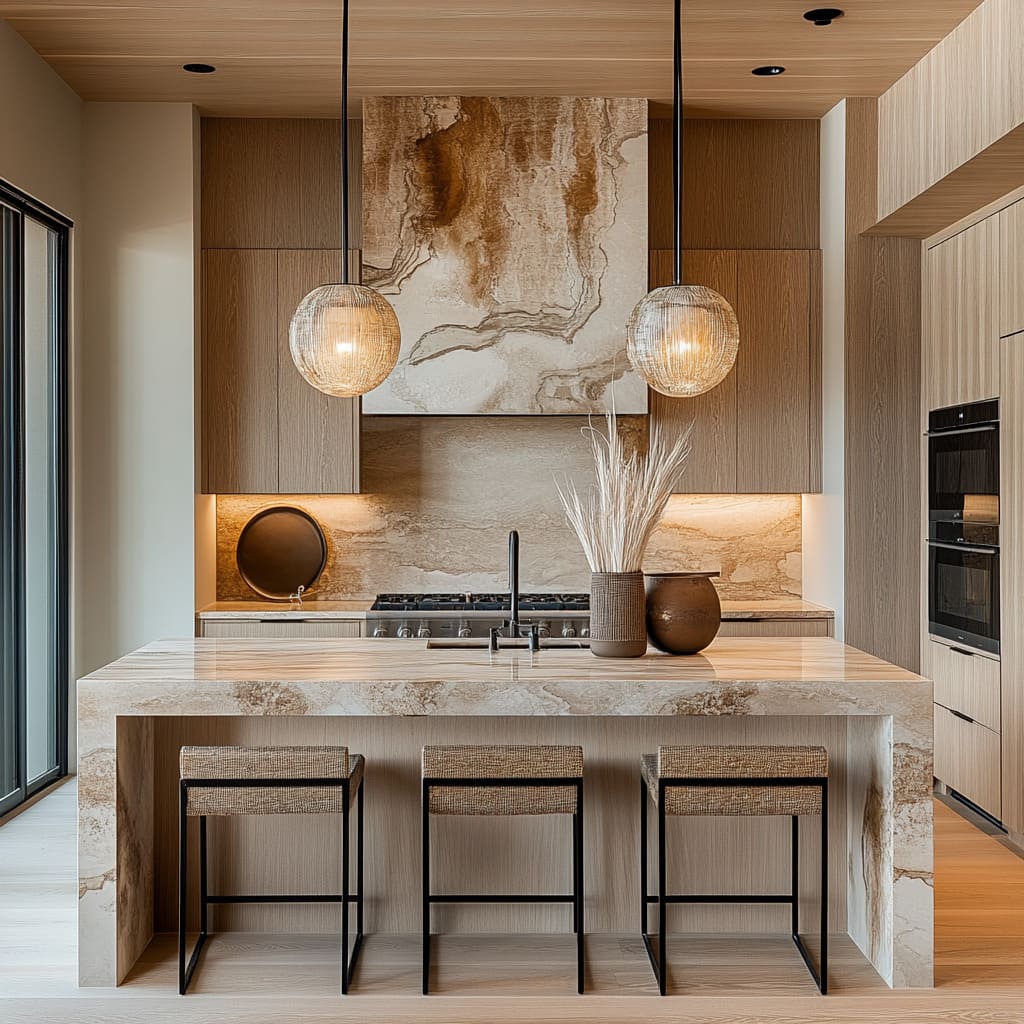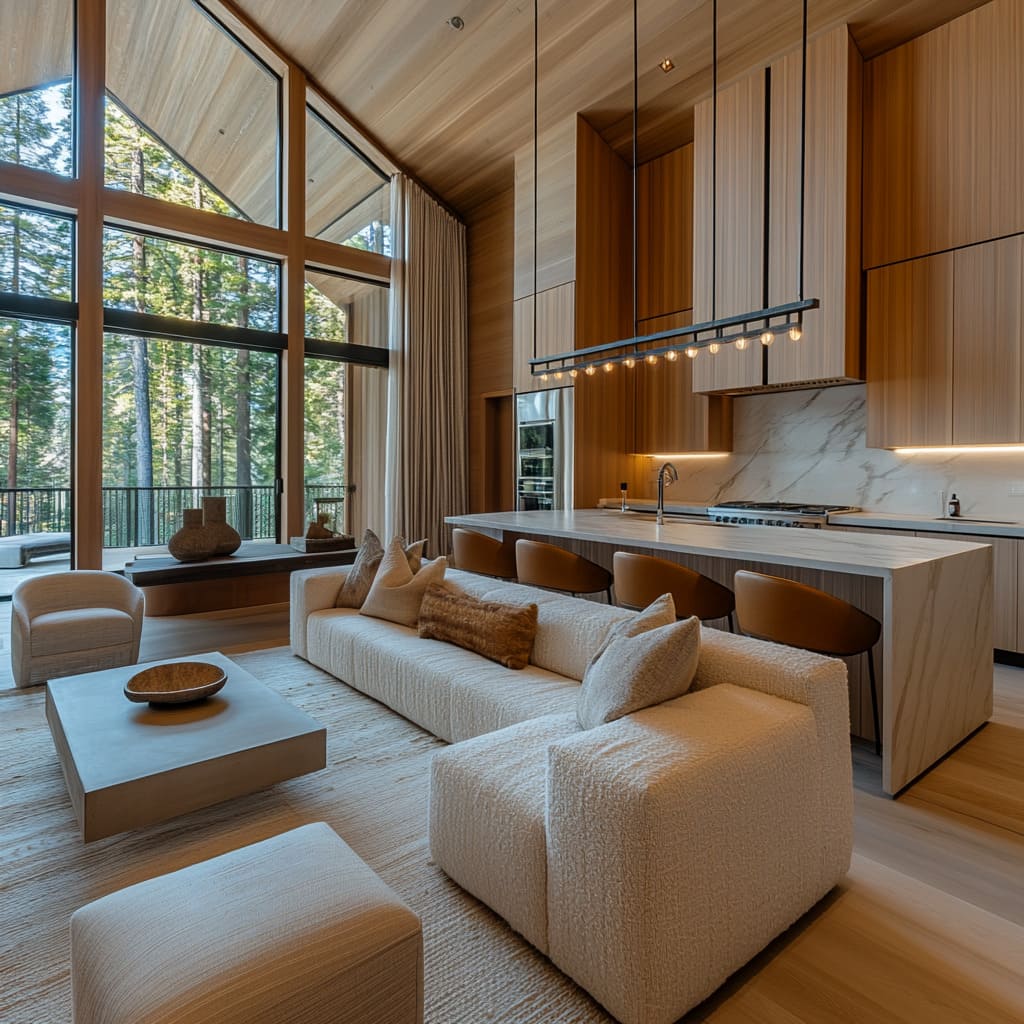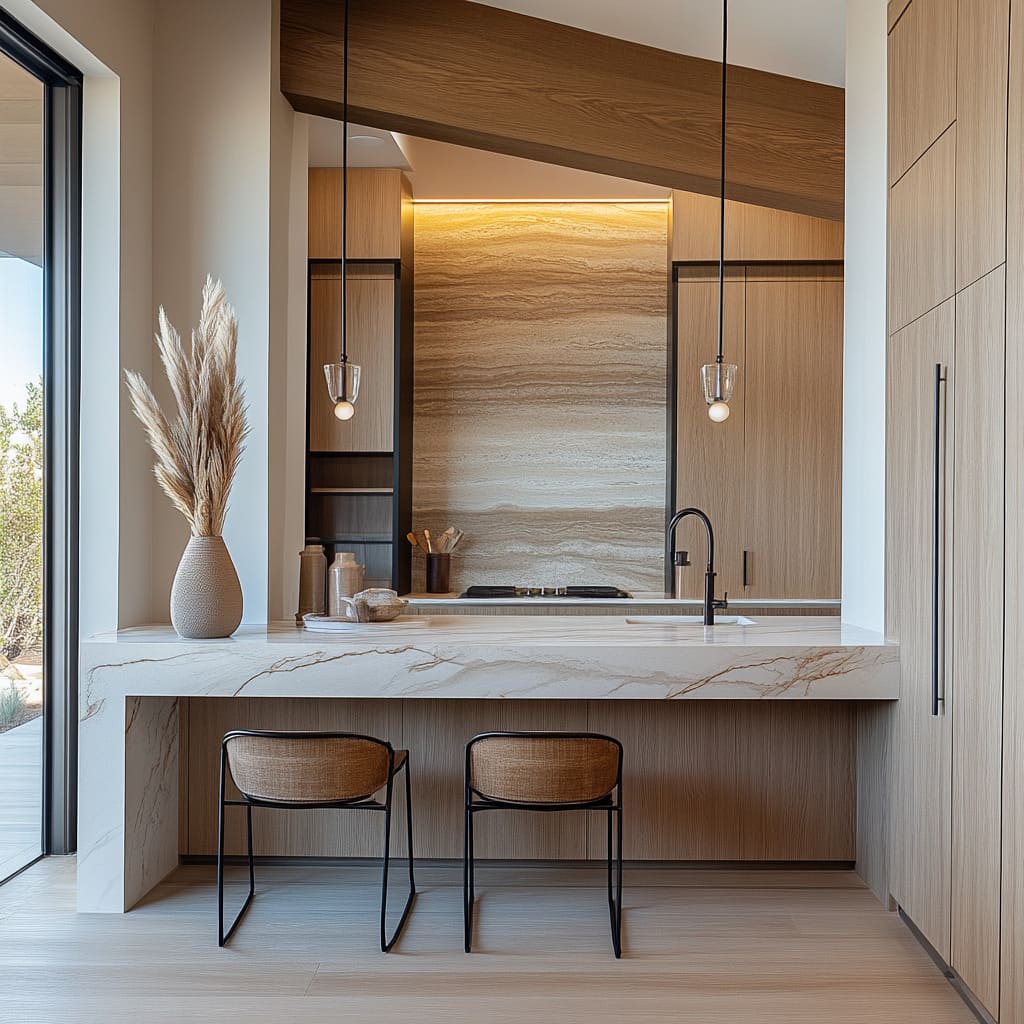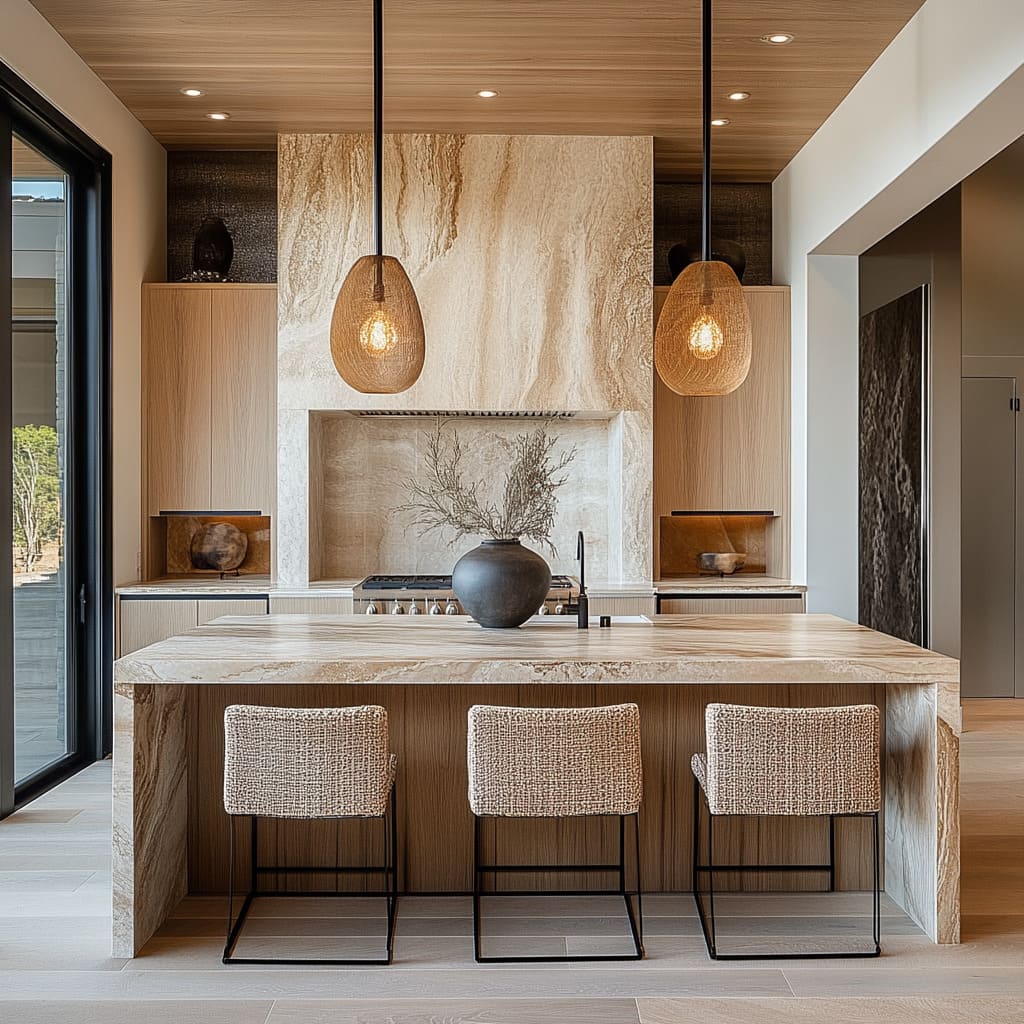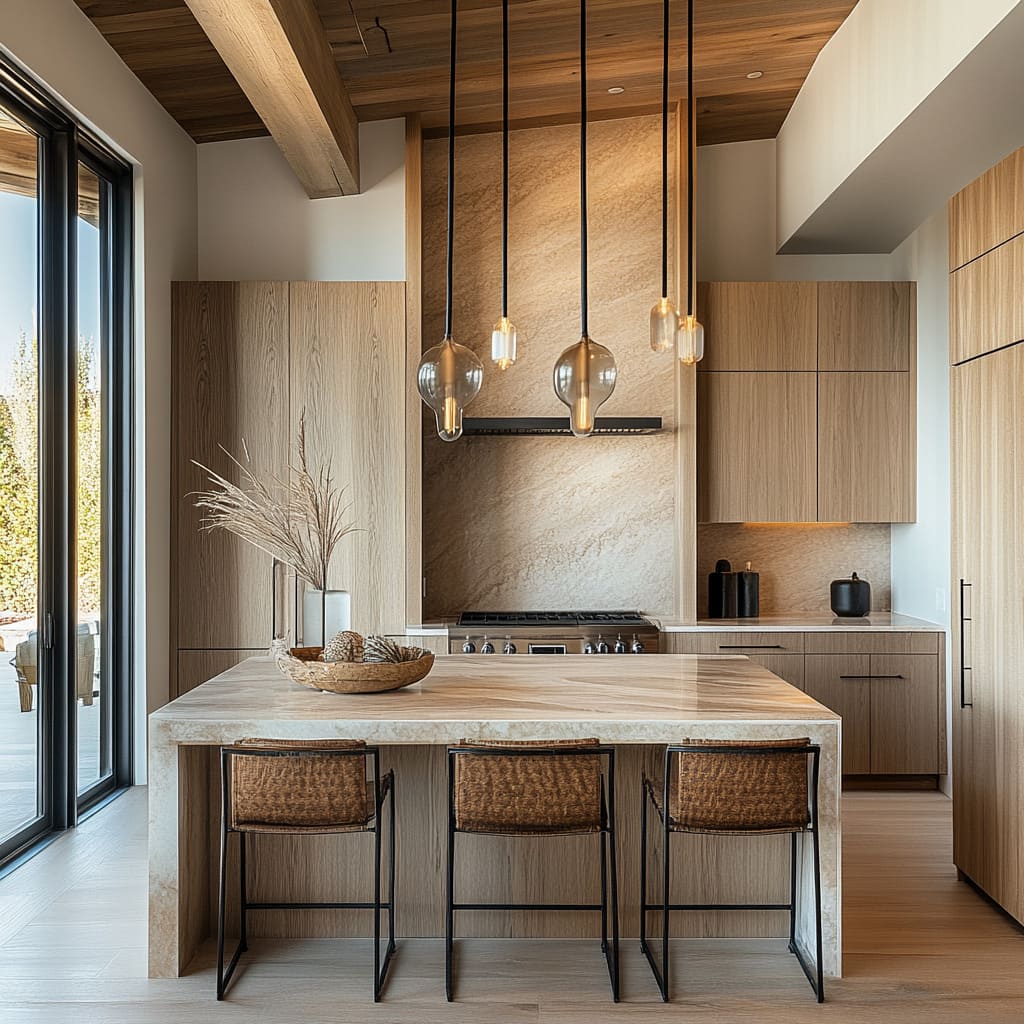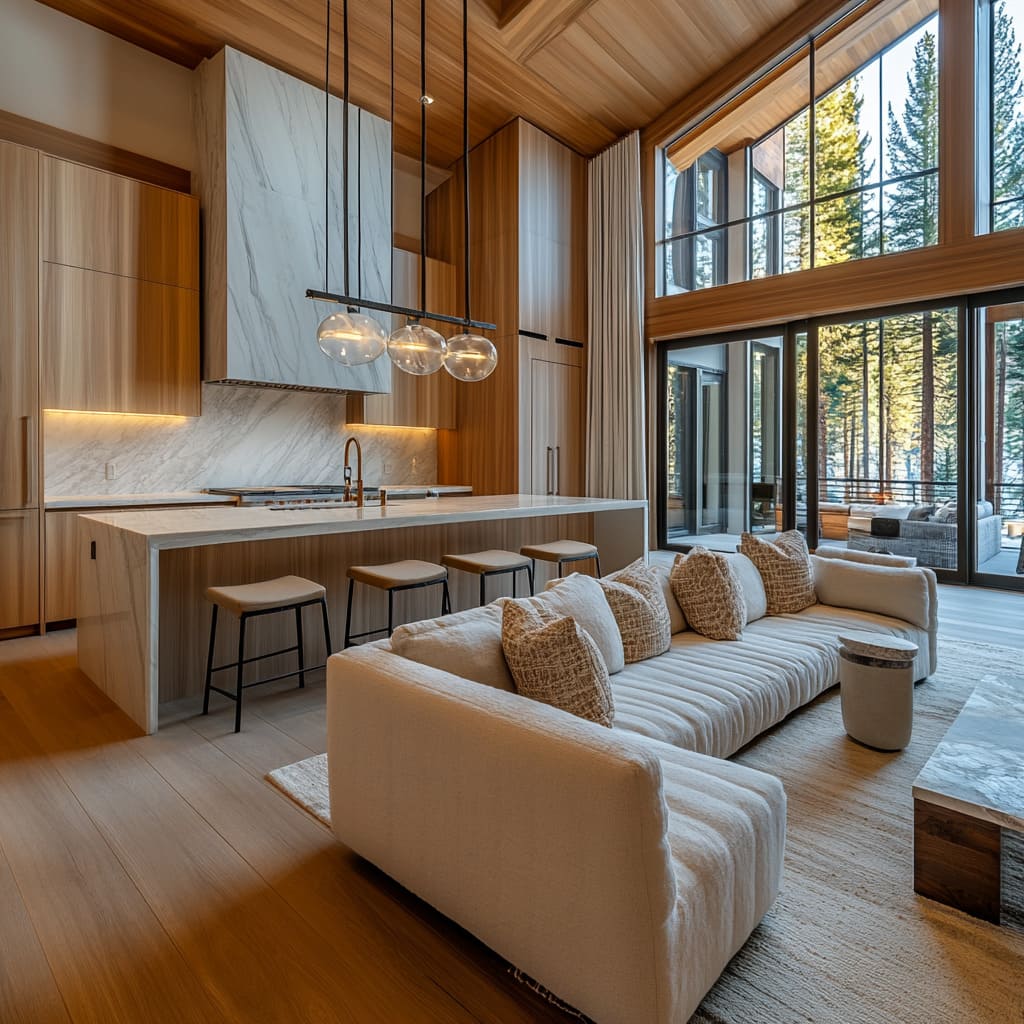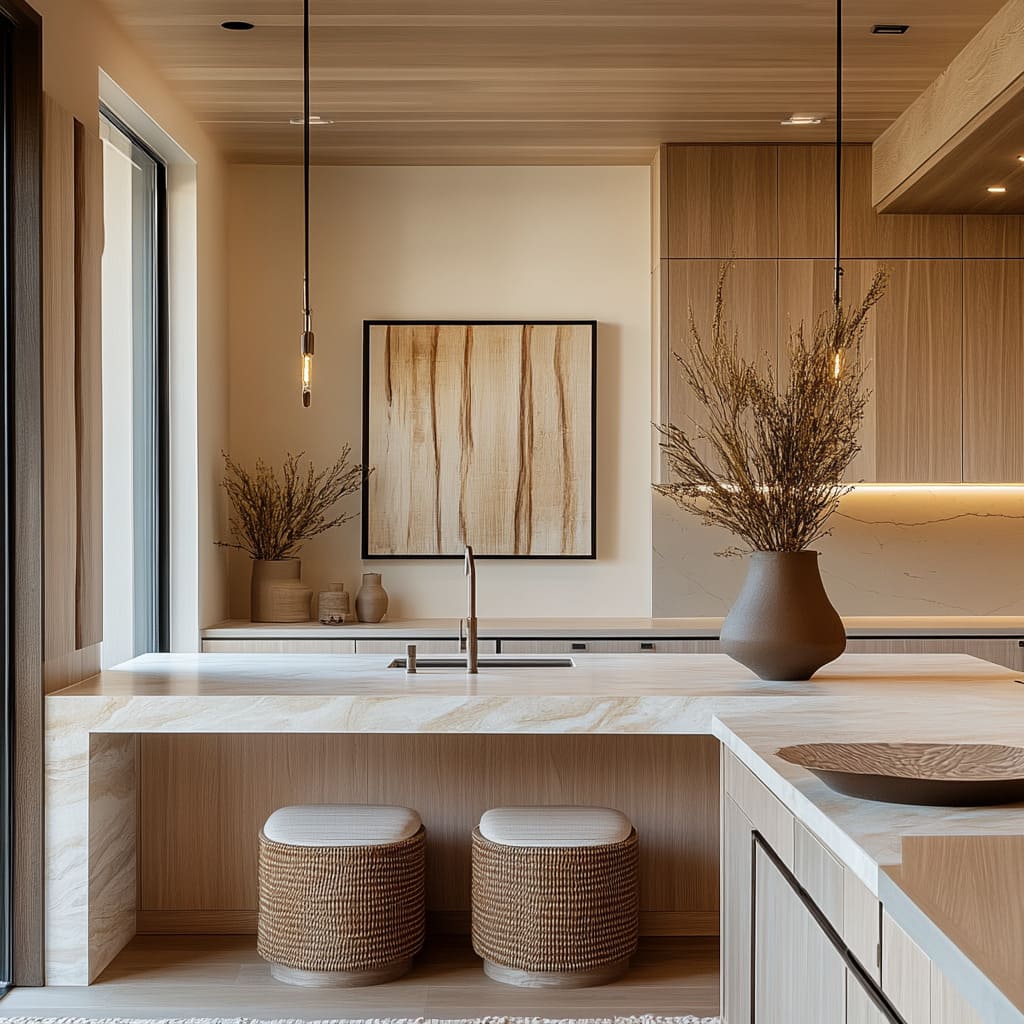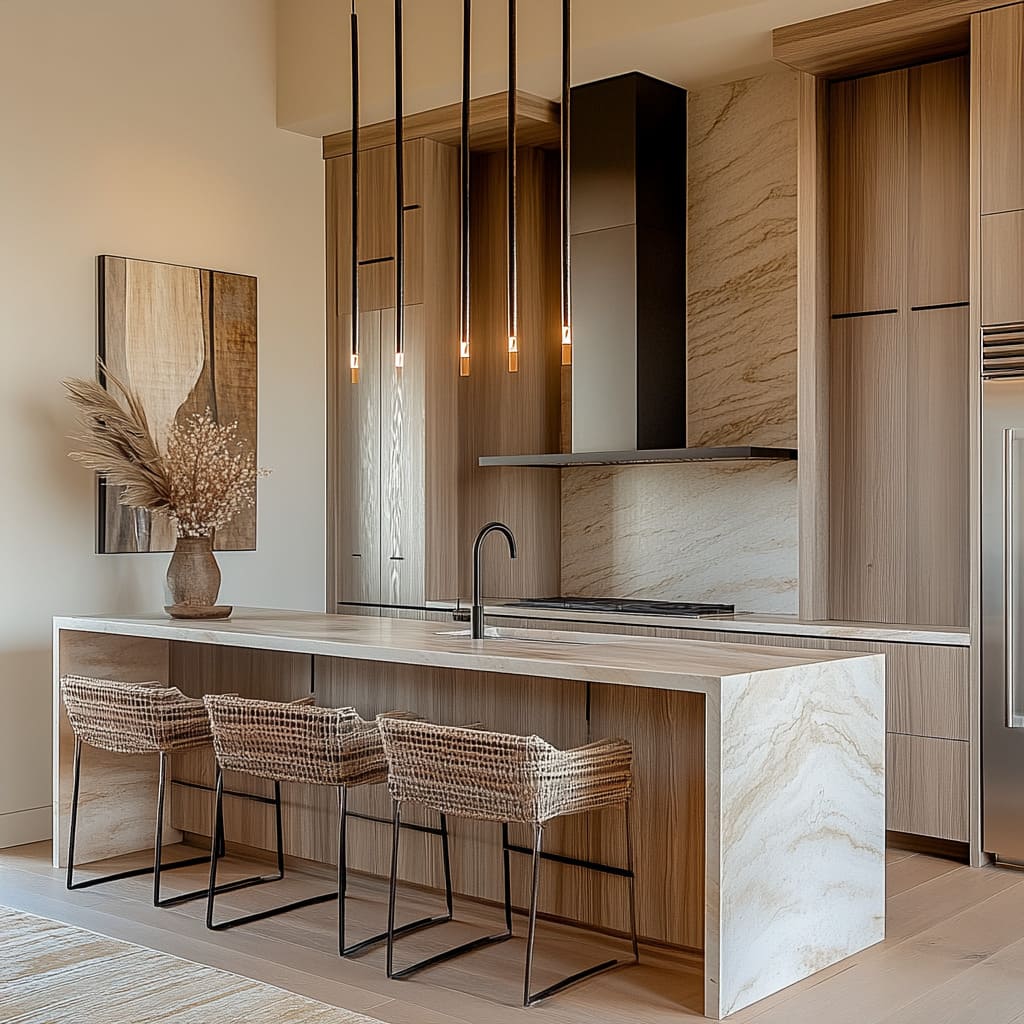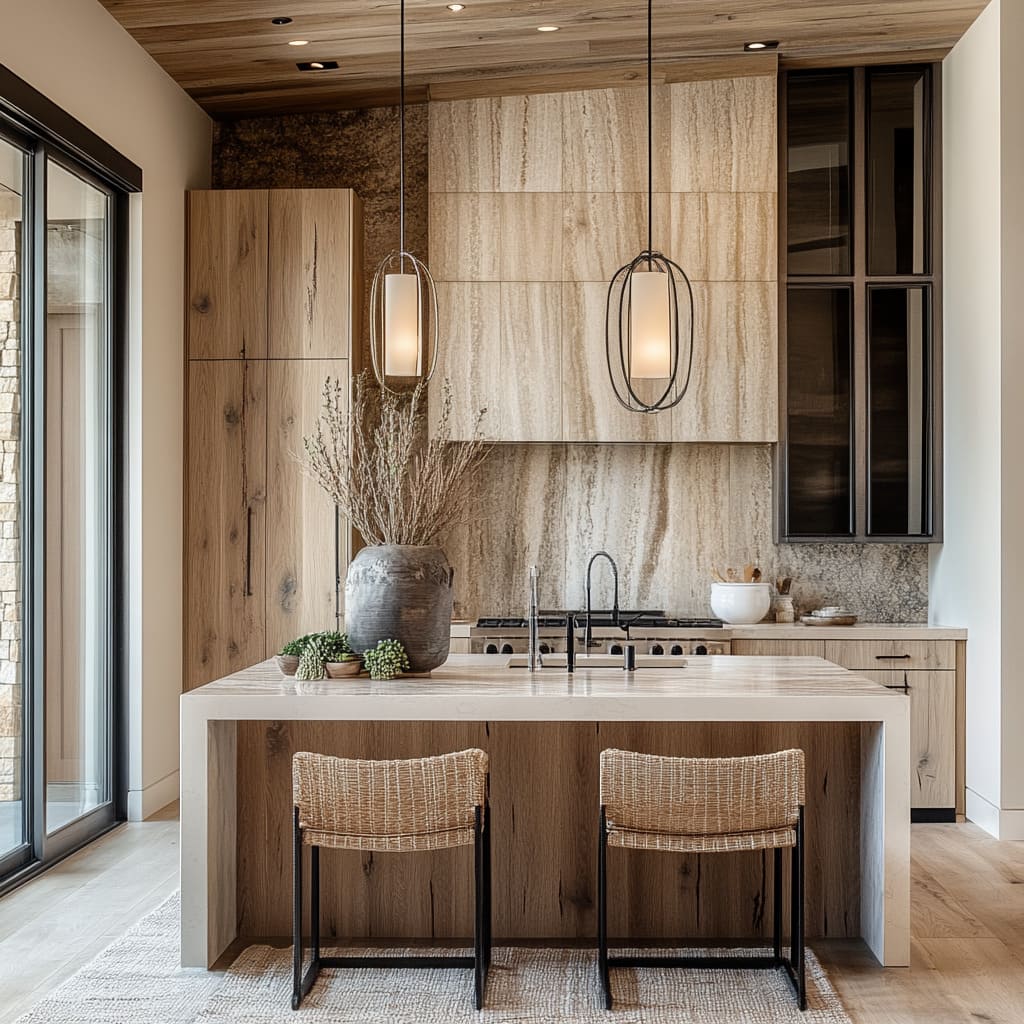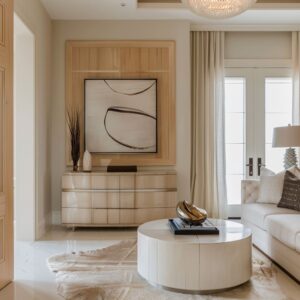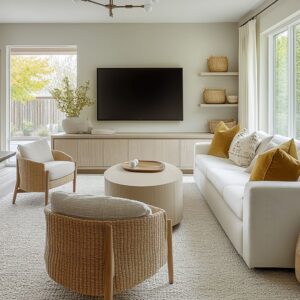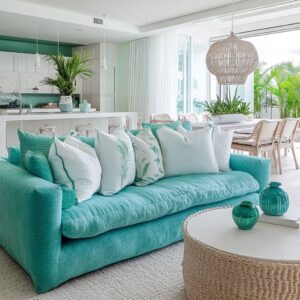In recent years, a notable trend in kitchen design has emerged: earthy minimalism. This style blends the warmth of natural materials with the clean, understated lines of modern design, creating spaces that feel both inviting and sophisticated.
With a focus on textures like wood and stone, combined with luxurious finishes, earthy minimalism offers a refreshing take on the traditional kitchen. This design approach has captivated homeowners and designers alike, offering a balance of simplicity and elegance.
The integration of organic elements with sleek, minimalist features results in a kitchen that is not only functional but also a visual delight
The purpose of this article is to explore the concept of earthy minimalism in kitchen design. We will delve into how materials like wood, stone, and other natural elements are being artfully incorporated into contemporary kitchens, resulting in spaces that are both practical and aesthetically pleasing.
By examining the key themes of this design style, such as the use of natural materials, minimalist aesthetics, and luxurious finishes, we aim to provide a comprehensive understanding of how to create a kitchen that embodies this unique style. The focus will also include how open-concept layouts and strategic use of light and space contribute to the overall ambiance of an earthy modern luxury kitchen
The Essence of Earthy Minimalism in Kitchen Design
Definition and Characteristics
Earthy minimalism is more than just a design trend; it is a lifestyle choice that embraces the beauty of simplicity. At its core, this style emphasizes the use of natural materials and neutral color palettes, creating a space that feels grounded and harmonious.
The goal is to achieve a balance between simplicity and warmth, crafting a kitchen that is both luxurious and welcoming. This design philosophy rejects excess and clutter in favor of clean lines and thoughtful details.
The result is a space that feels calm and uncluttered, yet rich in texture and material quality
The hallmark of an earthy kitchen design lies in its ability to seamlessly blend organic materials with modern design elements. By focusing on natural materials like wood and stone, this style brings a sense of the outdoors inside, creating a connection with nature that is both soothing and inspiring.
The use of neutral tones, such as soft whites, warm grays, and muted browns, further enhances the natural aesthetic, creating a cohesive and calming environment. The addition of luxurious finishes, such as polished stone countertops or high-end fixtures, elevates the overall design, adding a touch of sophistication and elegance
Key Elements
Several key elements define an earthy kitchen design, making it distinct from other styles. The first and most important element is the use of natural materials.
Wood, stone, and metal are staples in this design, each contributing to the overall aesthetic in different ways. Wood is often used for cabinetry, flooring, and ceiling treatments, adding warmth and texture to the space.
Stone, with its natural veining and rich patterns, is commonly used for countertops and backsplashes, adding a sense of luxury and durability. Metal is often incorporated in fixtures, hardware, and lighting, providing a modern contrast to the organic elements and adding a sleek, contemporary edge
Functionality is another crucial element of earthy kitchen design. This style prioritizes clean lines and clutter-free spaces, ensuring that every element serves a purpose.
The layout is often open and spacious, allowing for easy movement and interaction. Storage solutions are integrated seamlessly into the design, maintaining the minimalist aesthetic while providing ample space for kitchen essentials.
The focus on functionality ensures that the kitchen is not only beautiful but also practical and efficient
Luxury finishes and fixtures play a significant role in defining an elegant luxury modern kitchen design. High-quality materials like marble, quartz, and premium wood finishes are often used to create a sense of refinement and sophistication.
These finishes add a touch of opulence to the kitchen, elevating the overall design and creating a space that feels both comfortable and luxurious
The Role of Natural Materials in Kitchen Design
Wood: The Foundation of Earthy Aesthetics
Wood is the cornerstone of earthy modern kitchen design, providing both warmth and character to the space. It is commonly used for cabinetry, flooring, and ceiling treatments, adding a natural texture that is both visually appealing and tactile.
The type of wood finish can significantly impact the overall aesthetic of the kitchen. Natural oak, walnut, and other light-toned woods are popular choices, each bringing its unique grain pattern and color variation.
These finishes enhance the earthy feel of the kitchen, creating a sense of connection with nature
The grain and texture of the wood are crucial in defining the kitchen’s character. A finely grained wood finish can create a sleek, modern look, while a more pronounced grain pattern adds a rustic touch.
The choice of wood finish should complement the overall design, enhancing the natural beauty of the material and contributing to the earthy tone kitchen ideas. By incorporating wood in various elements of the kitchen, such as cabinetry, shelving, and ceiling beams, a sense of continuity and cohesion is achieved, creating a harmonious and balanced environment
Stone: Adding Luxury and Durability
Stone is another essential material in luxury modern kitchen designs, offering both visual appeal and practical benefits. Natural stone materials like marble, granite, and quartz are often used for countertops and backsplashes, providing a sense of luxury and durability.
The natural veining and rich patterns of these stones add depth and texture to the kitchen, creating a striking focal point that enhances the overall design
The visual and tactile appeal of stone lies in its unique characteristics. Each slab of stone is different, offering a one-of-a-kind pattern that adds character and charm to the kitchen.
The polished or honed finishes of the stone can vary from a high-gloss, reflective surface to a more matte, understated look, depending on the desired effect. Stone is also known for its durability, making it an excellent choice for high-traffic areas like the kitchen.
Its ability to withstand heat, moisture, and heavy use ensures that it will maintain its beauty for years to come
Complementary Materials: Metal and Glass
While wood and stone are the primary materials used in earthy kitchens, metal and glass also play important roles in adding modernity and sophistication to the design. Metal is often used in fixtures, hardware, and lighting, providing a sleek, contemporary edge that contrasts with the natural materials.
The use of metals like brushed nickel, stainless steel, or matte black adds a touch of industrial chic, enhancing the overall aesthetic without overpowering the natural elements
Glass is another complementary material that can enhance the light and airy feel of an earthy kitchen. Used in lighting fixtures and accessories, glass adds a layer of sophistication and elegance to the design.
It reflects light beautifully, enhancing the overall brightness of the space and creating a sense of openness. By integrating glass elements into the design, a balance is achieved between transparency and solidity, lightness and substance, further enhancing the earthy aesthetic
Find Out How Your Budget Shapes Your Home Renovation Dreams
Not sure what your budget can handle? Whether you’re considering a small update or a complete overhaul, our calculator helps you understand your options. From modern farmhouse kitchens to open-plan living spaces, see what kind of renovation fits your financial plan.
[budget_renovation_calculator]
Luxury Finishes and Their Impact
Countertops and Backsplashes: The Pinnacle of Luxury
In the world of contemporary luxury kitchen design, countertops and backsplashes are more than just functional surfaces; they serve as the central elements that define the kitchen’s overall aesthetic. The choice of materials for these surfaces plays a significant role in setting the tone for the space, especially when aiming for an earthy yet luxurious feel
Marble and quartz are two of the most popular choices for countertops in modern kitchen luxury. Marble, with its timeless appeal, brings a sense of elegance and sophistication to the kitchen.
Its unique veining patterns create visual interest, making each countertop a statement piece in its own right. The cool, polished surface of marble not only adds a touch of luxury but also serves as a durable and heat-resistant work area.
Quartz, on the other hand, offers a balance of beauty and practicality. Available in a wide range of colors and patterns, quartz countertops can mimic the look of natural stone while providing increased durability and ease of maintenance.
This makes quartz an ideal choice for homeowners who desire the luxurious appearance of marble without the upkeep
Backsplashes in contemporary luxury modern kitchen designs are also evolving to become focal points in their own right. Full-height backsplashes that extend from the countertop to the underside of the upper cabinets or even to the ceiling create a striking visual continuity.
This design choice not only enhances the feeling of height in the kitchen but also allows the eye to travel seamlessly across the space, amplifying its overall grandeur. The use of the same material for both the countertop and backsplash, such as marble or quartz, furthers this cohesive look, creating a seamless flow that exudes luxury.
Alternatively, some designs feature statement materials for the backsplash, such as hand-crafted tiles or metallic accents, adding texture and a unique character to the kitchen
Cabinetry and Hardware: Minimalist Yet Elegant
Cabinetry is a fundamental aspect of achieving a minimalist aesthetic in any kitchen, particularly in designs that prioritize a balance between simplicity and elegance. The use of flat-panel doors is a hallmark of this style, providing clean, uninterrupted surfaces that contribute to the sleek, modern look.
Integrated handles or touch-latch mechanisms further enhance this aesthetic by eliminating the need for visible hardware, maintaining the cabinetry’s seamless appearance. This approach to cabinetry design is essential in creating a kitchen that feels uncluttered and refined, allowing the natural beauty of the materials to take center stage
High-end hardware finishes also play a crucial role in adding subtle luxury to the kitchen. Brushed nickel, matte black, and antique brass are popular choices that offer a refined, understated elegance.
These finishes complement the minimalist design while providing a touch of contrast against the cabinetry’s wood tones or painted surfaces. In an earthy kitchen decor, the careful selection of hardware can elevate the overall look, transforming simple cabinetry into an element of sophisticated design
Flooring and Ceiling Treatments: Enhancing Warmth and Cohesion
The choice of flooring and ceiling treatments in a kitchen significantly influences the overall ambiance and feel of the space. Wide plank wood flooring is a favored option in earth tone kitchen designs due to its ability to add warmth and texture.
The natural grain patterns and color variations in wood create a welcoming environment that feels both luxurious and grounded. When extended into the adjacent living areas, wood flooring enhances the sense of continuity, making the kitchen feel like an integral part of a larger, cohesive space
Matching ceiling treatments, such as wood paneling or exposed beams, further enhance this cohesive feel. By echoing the material used on the floor, the ceiling treatment draws the eye upward, expanding the perception of space and creating a sense of harmony throughout the kitchen and adjoining areas.
The result is a unified, expansive feel that is particularly effective in open-plan kitchens, where the boundaries between different functional areas are fluid and interconnected
Lighting in Earthy Minimalist Kitchens
Natural Light as a Design Element
Natural light is a vital component of any earthy kitchen idea, especially in designs that emphasize warmth and natural materials. Large, floor-to-ceiling windows are often used to flood the kitchen with natural light, enhancing the beauty of the wood, stone, and other natural elements.
This abundance of daylight brings out the subtle variations in color and texture, highlighting the organic qualities of the materials and creating a dynamic, ever-changing play of light and shadow. The result is a kitchen that feels alive and connected to the natural world, blurring the lines between indoor and outdoor spaces
Artificial Lighting: Balancing Functionality and Ambiance
In addition to natural light, artificial lighting is crucial in balancing functionality with ambiance in modern kitchens. A well-designed lighting plan typically includes a combination of pendant lights, recessed lighting, and under-cabinet lighting to create layers of light that serve different purposes.
Pendant lights, often placed over kitchen islands or dining areas, provide focused task lighting while also serving as decorative elements that enhance the kitchen’s style. Recessed lighting offers general illumination, ensuring that the entire kitchen is well-lit, while under-cabinet lighting adds a soft, ambient glow that highlights countertops and backsplashes, making tasks easier and safer
The choice of light fixtures should complement the overall aesthetic of the kitchen. In an earthy minimalist kitchen, fixtures with natural materials, such as wood, glass, or metal, are ideal.
These materials not only align with the earthy theme but also add a layer of sophistication to the design. By carefully selecting lighting fixtures that enhance the overall aesthetic, homeowners can create a kitchen that feels both functional and inviting, with a warm and welcoming ambiance
Open-Concept Layouts and Spatial Planning
Benefits of Open-Concept Kitchens
Open-concept layouts have become increasingly popular in modern kitchen luxury designs, as they promote a sense of flow and connectivity between the kitchen, dining, and living areas. This layout is particularly beneficial in homes where the kitchen is considered the heart of the living space, serving as a hub for socializing and entertaining.
By removing walls and barriers, an open layout allows for easy movement between different areas, making the space feel larger and more expansive
The kitchen island plays a pivotal role in defining space within an open-concept layout. It acts as a boundary that separates the kitchen from the adjacent living or dining areas without interrupting the flow.
The island also serves multiple functions, from providing additional workspace and storage to offering a casual dining spot. In contemporary luxury kitchen designs, the island is often treated as a focal point, with distinctive materials and finishes that set it apart from the surrounding cabinetry
Integrating Living Areas with Kitchen Spaces
In open-plan homes, it is essential to create a seamless transition between the kitchen and living areas. This can be achieved through the use of consistent materials and color palettes that tie the different spaces together.
For example, using the same type of wood for both the kitchen cabinetry and the living room furniture creates a cohesive look that enhances the sense of unity. Similarly, a consistent color palette of earth tones, such as warm grays, soft whites, and muted browns, helps to create a harmonious flow between the spaces.
Furniture and decor choices also play a significant role in maintaining an open, cohesive feel. In an earthy kitchen design, selecting furniture with natural materials and simple, clean lines ensures that the overall look remains cohesive and uncluttered.
Accessories, such as rugs, cushions, and decorative objects, should complement the earthy color palette and materials used in the kitchen, further enhancing the sense of continuity and cohesion
By thoughtfully integrating the kitchen with the adjoining living areas, homeowners can create a space that feels both connected and expansive, perfectly suited to the needs of modern living. This approach not only enhances the functionality of the kitchen but also creates a welcoming environment that is ideal for both everyday use and entertaining
Decorative Elements and Personalization
Incorporating Natural Decor
Incorporating natural decor elements is an essential aspect of creating an earthy minimalist kitchen that feels both inviting and authentic. The use of plants, vases filled with fresh or dried foliage, and organic textures can significantly enhance the natural feel of the kitchen.
These elements introduce a layer of softness and vibrancy that complements the clean, minimalist lines typically found in high-end modern kitchens. Plants are a versatile decor choice that not only add a touch of greenery but also improve the air quality and bring life into the space.
Consider placing potted herbs on a windowsill or incorporating larger plants like fiddle leaf figs or snake plants in decorative pots on countertops or in corners. The greenery contrasts beautifully against the natural tones of wood and stone, adding a fresh element to the kitchen’s aesthetic
Vases with foliage, whether fresh flowers or branches, add another dimension of natural beauty to the space. These can be strategically placed on kitchen islands, countertops, or open shelving to draw the eye and create focal points.
The use of neutral or earthy-colored vases complements the overall design while introducing subtle variations in texture and form. Organic textures, such as woven baskets or wooden bowls, can also be used to add depth and interest.
These pieces soften the sleek surfaces of luxury modern kitchen cabinets, creating a balanced look that is both sophisticated and warm
Balancing Minimalism with Personality
While minimalism favors simplicity and restraint, there is always room to infuse personality into a kitchen without compromising its clean aesthetic. The key is to add personal touches that are subtle yet impactful, avoiding any clutter that would detract from the minimalist design.
One way to achieve this is through the use of carefully selected decor items that reflect personal style and taste
Ceramic bowls, artisanal glassware, and handcrafted pottery are excellent examples of decor items that can enhance the kitchen’s appeal without overwhelming the space. These pieces can be displayed on open shelves or countertops, where they add a touch of artistry and craftsmanship.
Opt for items in muted or earthy tones to maintain the cohesive color palette of the kitchen. Additionally, consider using kitchen essentials, such as salt and pepper mills, cutting boards, and storage jars, as decorative accents.
By selecting items with interesting textures or materials, these everyday objects can double as stylish accessories that contribute to the overall design
Another approach is to integrate a few personal items, such as family heirlooms or souvenirs from travels, in a way that feels intentional rather than random. This could include a single, well-placed decorative plate on a display stand or a small collection of vintage cooking utensils hung neatly on a wall.
The goal is to add personality without cluttering the visual landscape, maintaining the kitchen’s serene and orderly appearance
Examples of Earthy Minimalism in Action
The Modern Rustic Kitchen
A modern rustic kitchen is a perfect example of how earthy minimalism can be achieved by blending rustic elements with modern finishes. In such a kitchen, reclaimed wood is used extensively for cabinetry and ceiling beams, providing a sense of warmth and character.
The wood’s natural patina and imperfections add a layer of authenticity that contrasts beautifully with sleek, minimalist surfaces like polished stone countertops and stainless steel appliances. Stone is another key material in this design, used for both the countertops and the backsplash.
The stone’s natural veining and texture complement the wood, creating a harmonious blend of materials that feels both luxurious and grounded. This kitchen achieves a delicate balance between warmth and contemporary sophistication by combining rustic charm with modern minimalism.
The result is a space that feels inviting and comfortable, yet refined and stylish
The Luxurious Nature-Inspired Kitchen
In this case, the focus is on creating a luxury feel through the extensive use of natural materials. The kitchen features marble countertops with bold veining that makes a statement, paired with light wood cabinetry that adds warmth and texture.
This combination of materials creates a striking contrast that enhances the kitchen’s overall aesthetic
High-end finishes and fixtures further elevate the design. Matte black hardware and modern light fixtures provide a contemporary edge, while the use of high-gloss cabinetry fronts adds a touch of luxury.
The thoughtful integration of these elements results in a kitchen that feels both earthy and luxurious, perfectly capturing the essence of stylish luxury modern kitchen designs. This space is a testament to how natural materials, when combined with luxury finishes, can create a kitchen that is both functional and breathtaking
The Open-Plan Family Kitchen
An open-plan family kitchen serves as the heart of the home, emphasizing both functionality and style. This type of kitchens is designed with family living in mind, featuring a spacious layout that allows for easy movement and interaction.
The use of durable natural materials, such as wide plank wood flooring and sturdy stone countertops, ensures that the kitchen can withstand the demands of a busy household while still looking beautiful
Spatial planning is key in this design. The kitchen island, with its integrated seating, serves as a central gathering spot for meals and conversation, bridging the gap between the cooking area and the living space.
The use of consistent materials and a cohesive color palette throughout the open-plan layout helps to create a seamless transition between the kitchen and adjacent areas, maintaining a unified feel. This approach not only enhances the functionality of the space but also fosters a warm, welcoming environment that is perfect for both everyday family life and entertaining guests
Conclusion
Earthy minimalism in kitchen design is about more than just aesthetics; it’s about creating a space that feels both luxurious and grounded. By combining natural materials, minimalist principles, and luxurious finishes, these designs achieve a perfect balance between form and function.
Whether through the use of modern luxury kitchen cabinets, thoughtful lighting, or personalized decor, the goal is to create a kitchen that is both beautiful and practical
Earthy minimalist kitchens offer a unique blend of style and practicality, making them an excellent choice for anyone looking to create a space that reflects their personality while remaining functional and timeless. By exploring the principles outlined in this article, homeowners can find inspiration to bring their own earthy kitchen ideas to life, creating a kitchen that truly feels like the heart of the home

